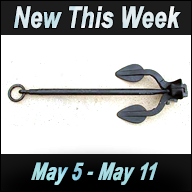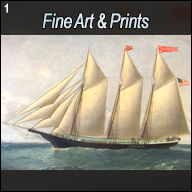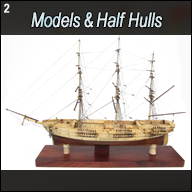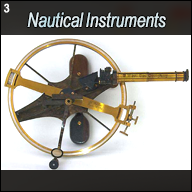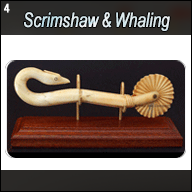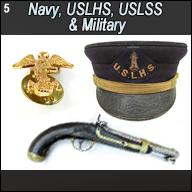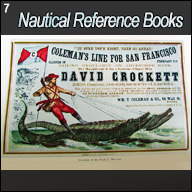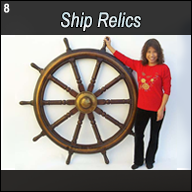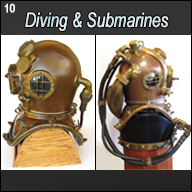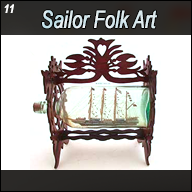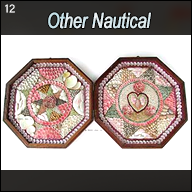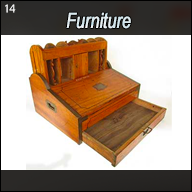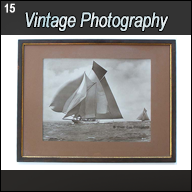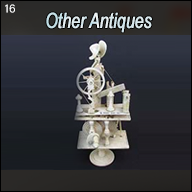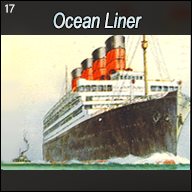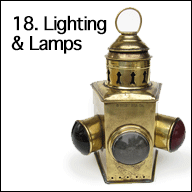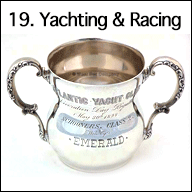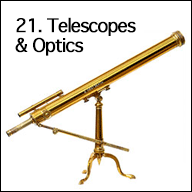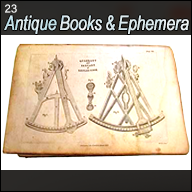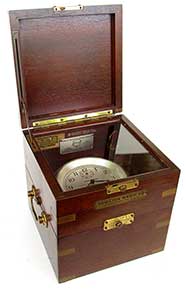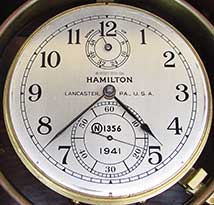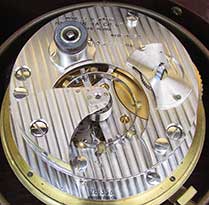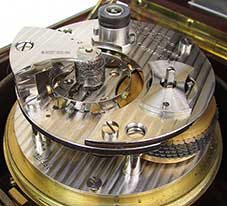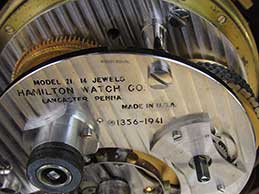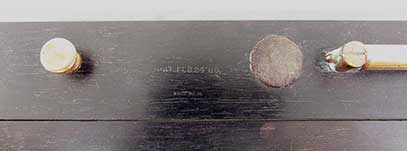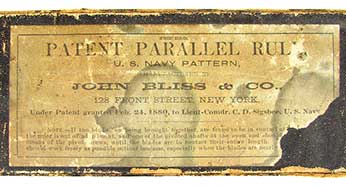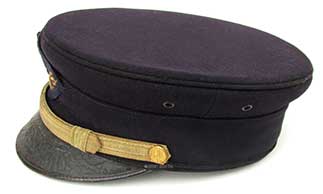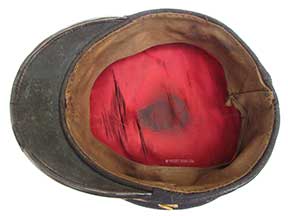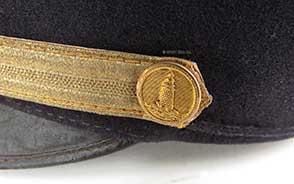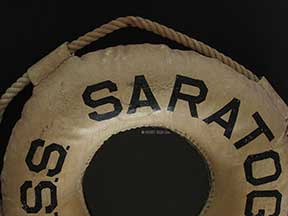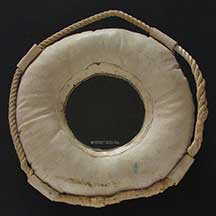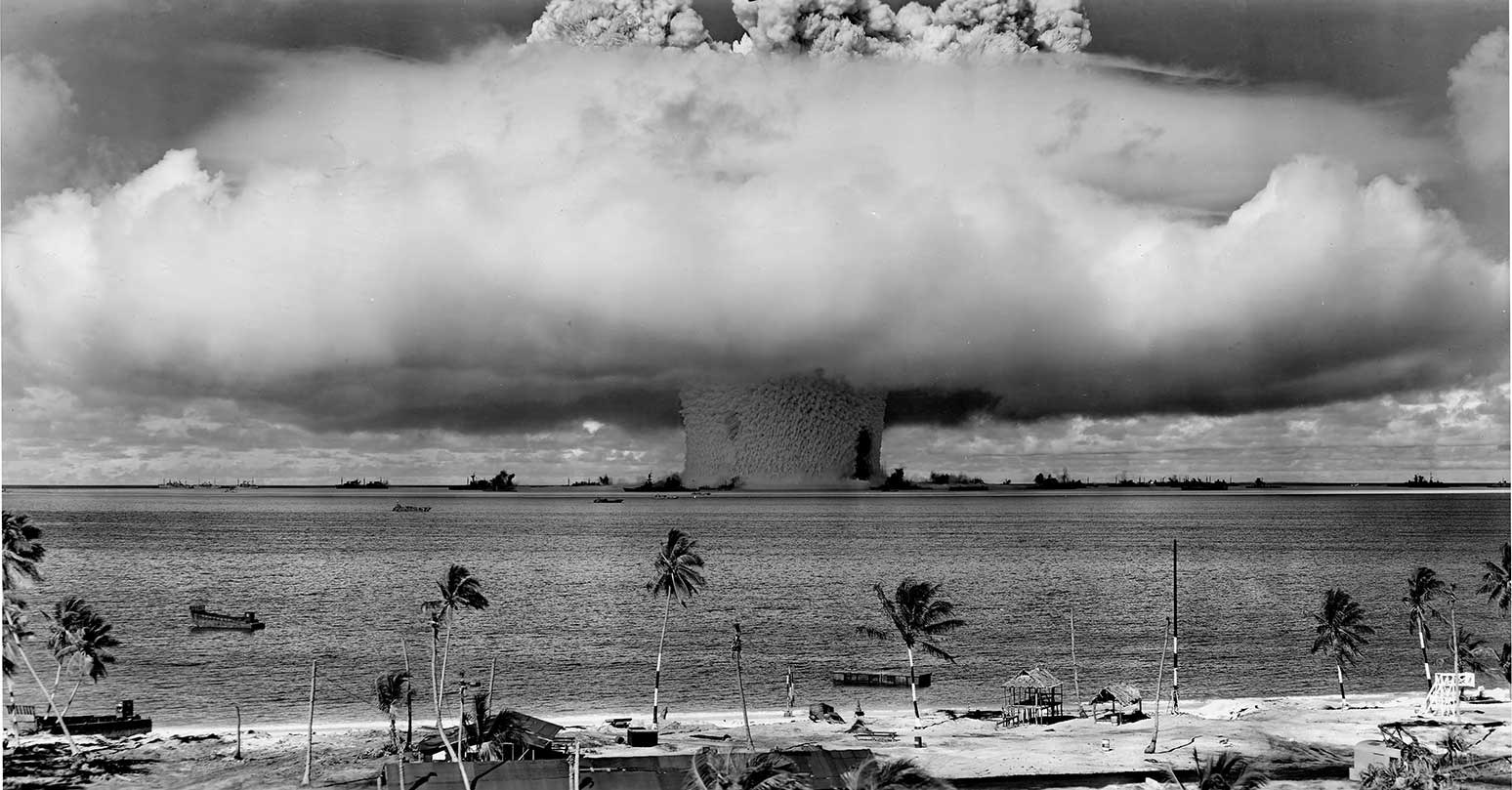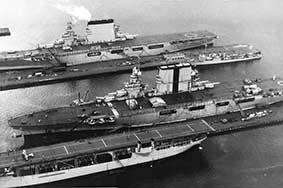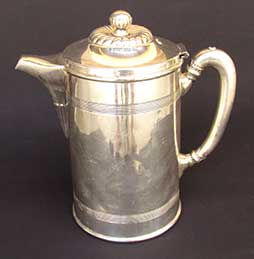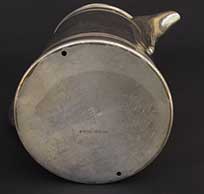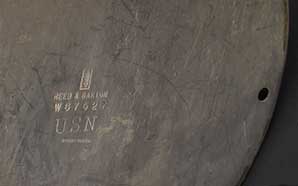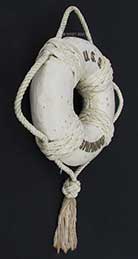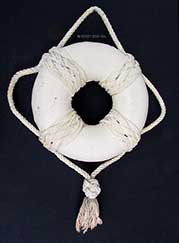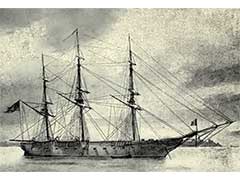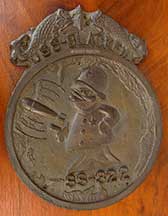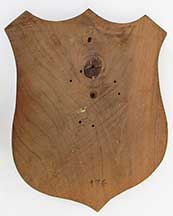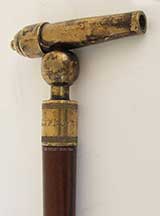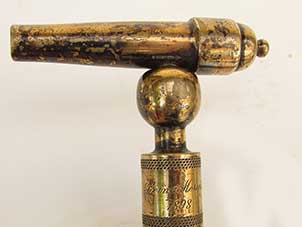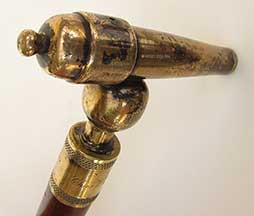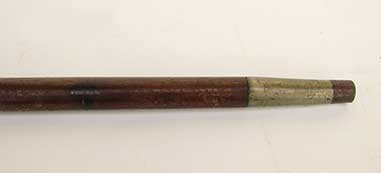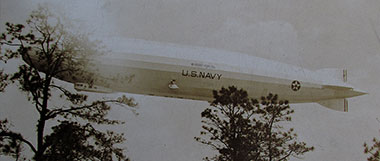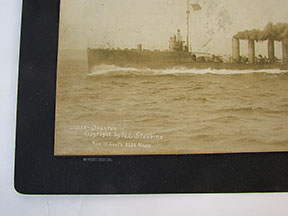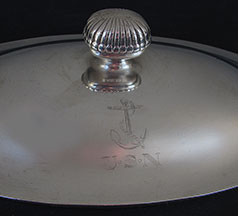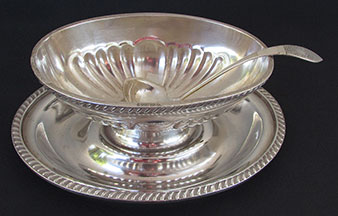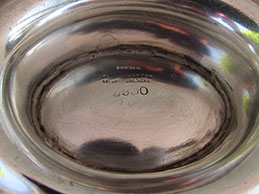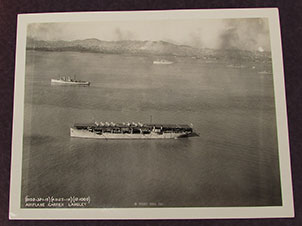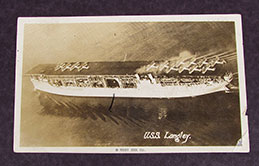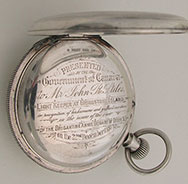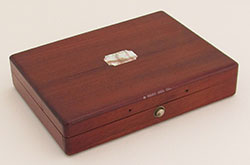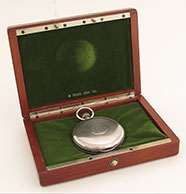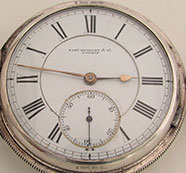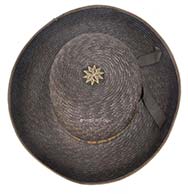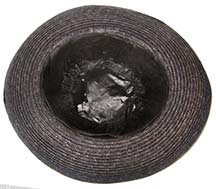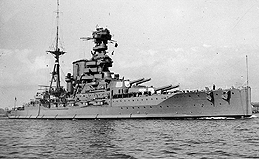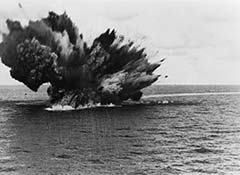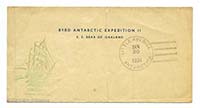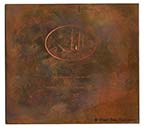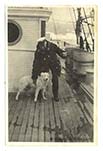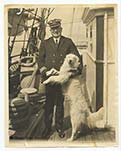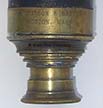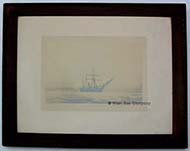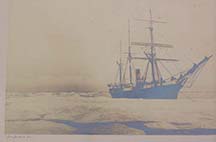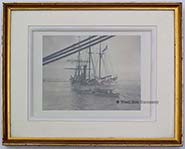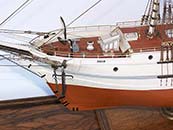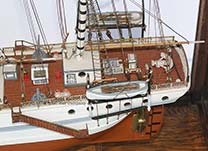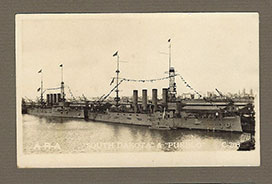5. NAVY, USLHS, USLSS & Military
Prices in U.S. Dollars are in GREEN
 |
5.82 SIGNALMAN’s TRAINING DEVICE. World War II or earlier hand-held teaching aid for training Navy signalmen to send Morse Code using flashing light. This ingenious device is made of stiff cardboard with louvers simulating a signal light for transmitting “INTERNATIONAL MORSE CODE” as indicated on the back. All 26 letters of the alphabet and numbers 0 - 9 are indicated with their corresponding code. The front is marked “PRESS DOWN… MAKE BACK BULGE,” cleverly simulating the emission of light. The back is marked “Patent Pending.” 2 ½ by 2 5/8 inches. Outstanding original condition. A rare, fragile survivor in working condition. 25 |
 |
 |
| back | flash |
 |
5.83 RARE NAVY NOZZLE. Authentic World War I or earlier shipboard firefighting nozzle used by the U.S. Navy. This heavy-duty fire nozzle is constructed of solid bronze. It is cast in relief at the bottom “3A FOG NOZZLE” and on the opposite side “PAT 1887 747.” What is special about this apparatus is that it represents the first attempt at using aeratedgenerated foam to smother a shipboard fire rather than just water. To these ends it has 6 exist ports on the end and 3 unique aspiration vents on the side for introducing air into the frothy mix. The opposite side of the nozzle is impressed with the distinctive Navy Inspector’s Mark |
 |
 |
| side | inside |
 |
| inspectors mark |
 |
5.79 ADMIRAL’s CUP. Very rare, World War II or earlier “watch stander’s” type cup bearing the flag of a full 4 star Admiral! The bottom of the cup is marked “TEPCO Vitrified China Made in U.S.A.” 3 ¼ inches in diameter by 3 ¼ inches high. There is a significant crack with chip in the upper right rim. Priced accordingly. Nevertheless, this cup was once in the possession of a recognized wartime Naval commander of major importance. If only it could talk! 29 |
 |
 |
| maker | crack |
 |
5.23/15.42 U.S.S. CALIFORNIA IMAGES. Three very early 1900’s images depicting the armored cruiser “CALIFORNIA.” The first is an original photograph entitled "Boat Deck U.S.S. California." The photo shows a sailor posed on a crane next to a lifering marked USS CALIFORNIA. Below are 2 early binnacles and 2 pelorus stands along with two wheeled ammunition limbers. The ship appears to be nested next to another capital warship with towering smokestack, huge funnels and a sailor leaning on the rail. 3 ½ by 5 ½ inches. This is an interesting identified professional photograph with very unusual subject matter. Pre-1910. The second is a period chromolithograph post card of the ship. It is captioned “U.S. ARMORED CRUISER “CALIFORNIA.” 800 OFFICERS AND MEN. LENGTH 502 FEET. MAIN BATTERY 18 GUNS.” The postcard is franked with a penny stamp and is postmarked MAY 1908. 3 ½ by 5 3/8 inches. The third is an artistic photograph of the famous ship underway with a full head of stem plowing through massive waves under stormy skies. Interestingly, the tip of the bow was enhanced by the artist/photographer with real gold! The image is signed lower right in fancy script “W. F. Henry Vallejo, CAL.” The image measures 4 by 9 ½ inches and is double matted under old wavy glass in its original gilt wood frame measuring 7 by 12 ½ inches. All three are in excellent condition. A rare compilation of 3 historic images of this famous California ship, all over 100 years old! 269 |
 |
 |
| photo | litho |
 |
 |
| ship detail | signature |
 |
5.80 NAVY AIRCRAFT RANGE FINDER. Authentic World War II U.S. Navy range finder used to assist in shooting down enemy aircraft. The back of this hand-held device bears the riveted maker’s label reading “U.S. NAVY BU ORD. A. A. RANGE INDICATOR Mark I Mod. 1 Made by the A.D. Gilbert Company New Haven, Conn, U.S.A. 1944” This early Bakelite computer uses parallax to determine the distance from an incoming aircraft to the observer. Using a cleaver system of levers and gears attached to 4 metal pointers, the two central wires were to be aligned with the aircraft’s “WING SPAN.” The pointers indicated the distance to the aircraft in feet. Obviously, it was incumbent on the observer to first identify the type of aircraft. Then, depending on that identification, several types of aircraft could be ranged from 500 to 3,000 feet away. Those included: “M’SCHMITT 109, TYPE OOVF (JAP.) TYPE 96 VF (JAP.), M’SCHMITT 110 FOCK-WOLF 187, DORNIER 17-215, JUNKERS 88, JUNKERS 87, TYPE 99 VB (JAP.), Z.511, CANT. Z 506B, FOCKE-WOLF KURIER, HEINKEL111K-115, JUNERS 86K, SAVOIA S.79, TYPE 97 VB (JAP.)” All are identified in incised orange lettering around the circumference. The back of the instrument is embossed “TO BE HELD 24 INCHES FROM THE EYE.” The instrument is 5 3/8 inches in diameter and 9 ½ inches high. It is in perfect original, functional condition. A very unusual wartime relic from World War II. WAS $395 NOW! 139 The use of optical range finding on land and sea was pioneered as early as the Civil War. It was obviated by the invention of radar in the Second World War. Yet this holdover of the antiquated technology still lingered as late as 1944. This example’s pristine condition is a testament to its obsolescence. |
 |
 |
| back | maker |
 |
5.77/11.88 U.S.C.G. SHIP IN A BOTTLE. Precise, hand-made ship in a bottle depicting the famous training ship, Bark EAGLE. This very detailed model is displayed under full sail plying a greenish blue sea. Both sides have the distinctive hull markings of a red stripe and “COAST GUARD.” The model is nicely rigged and shows painted details such as life lines and portholes. It is housed in a clear whiskey bottle embossed “TEACHER’S” top and bottom. The entire presentation is 11 inches long and 3 ½ inches high. Outstanding original condition. A rare subject of sailor folk art. 129 |
 |
| reverse |
 |
5.75/13.39 U.S. COAST GUARD CLOCK. Rare, very highly sought after ship’s clock made for the United States Coast Guard by the venerable Seth Thomas Clock Company soon after the First World War. This handsome survivor of that newly formed service has a blackened brass dial with bold Arabic numerals swept by classic spade hands enhanced by luminescent paint, typical of that period. All of the hour numerals are denoted with similar luminescent dots. Adding to its beauty, the numbers and letters are embossed (raised) shiny brass. The dial has a minute chapter ring indicating individual minutes, encompassed by its silvered reflector ring. The large subsidiary seconds bit at the bottom of the dial, below the center arbor, indicates individual seconds marked by 10’s. The winding arbor is below the “12” and the Fast/Slow regulator is adjacent the “9.” The high quality jeweled movement is housed in its original, very handsome heavy solid bronze case of classic ship’s clock form with screw-on bezel. The clock measures 7 3/8 inches in diameter and is 2 5/8 inches thick Complete with period antique brass winding key. This clock has just been fully serviced at a cost of $175 by a professional watch and clock expert. Without a doubt this is an exceptional survivor from the earliest days of the U.S. Coast Guard. Over 100 years old! 1495 Of all of the many historic clocks we have offered in our 45+ years, this is certainly one of the rarest and most desirable! In his landmark reference book “Military Timepieces” 1992, AWI Press, author Marvin Whitney depicts the movement of this clock on page 428, Figures 33 and 36. He writes, “SETH THOMAS MODEL NO. 117. This movement was used in the Navy’s Nos. 6, 60 and 80 marine clocks. The rectangular movement was powered by a single 8-day mainspring fitted with a 7-jewel movement and bi-metallic balance, circa 1924.” |
 |
 |
| perspective | dial |
 |
 |
| movement | back |
 |
5.74/13.32 EARLY U.S.N. BOAT CLOCK. Very sought after warship’s clock made by the venerable Seth Thomas Company of Thomaston, Connecticut for the United States Navy. This high grade relic from the “Great War” era has a blackened brass dial with bold silver Arabic numbers. It has a minute chapter ring swept by spade hands with silvered tips. It is marked “U.S. NAVY BOAT CLOCK” below the center arbor and just above the winding arbor. The subsidiary seconds bit is below the 12 showing single seconds marked by 10’s. The Fast/Slow adjustment is above the 12. The dial is encircled by its original silvered brass reflector ring. The classic flared marine clock case is made of heavy brass with a screw-on bezel. This is Seth Thomas’ model No. 112 with all brass, 7 jewel movement, Breguet type hair spring and compensated balance. The serial number is stamped on the middle plate 174** and the back plate is engraved “Seth Thomas, Thomaston , Conn.” The back of the clock case is stamped “924.” 4 ¾ inches in diameter and 2 1/8 inches deep. Outstanding original cosmetic condition in a bright brass finish. This clock has just been thoroughly serviced by a professional watch and clock expert and is an excellent timekeeper. Complete with period winding key. 849 According to Marvin Whitney, author of “Military Timepieces,” 1992, AWI Press on page 415, Seth Thomas began manufacturing its No. 112 Boat Clock shortly after World War I. An example with serial number 35147 is depicted as dating “Ca. 1924,” fully 17,500 production numbers later than the example offered here. * For the privacy of the buyer this serial number is being withheld. |
 |
 |
| PERSPECTIVE | DIAL |
 |
 |
| MOVEMENT | BACK |
 |
5.68/13.26 U.S. MARINE CORPS CLOCK. Scarce, very highly collectible pre-World War II vintage ship’s clock made for the United States Marine Corps by the venerable Chelsea Clock Company of Boston, Massachusetts. This handsome, first rate clock is solid brass with a nickel finish on the body. The silvered brass dial is marked with bold Arabic numerals and a minute chapter ring swept by beautifully blued steel spade hands. The subsidiary seconds bit above the center arbor indicates single seconds marked by 10’s. Above it is the Fast/Slow lever adjustment. Below the center is the winding arbor, and below it is the bold inscription “U.S. MARINE CORPS.” This clock contains Chelsea’s innovative model K movement only produced up until 1940. The serial number XXX507* indicates a date of 01.24.1940, nearly 2 years before America’s entry into World War II! The 5 ½ inch silvered brass dial is mounted in its original heavy brass case. The screw-on bezel measures 7 inches in diameter, whereas the mounting flange is just slightly larger at 7 5/8 inches in diameter. This clock is an excellent timekeeper running a week on a single wind. Complete with original winding key stamped “USMC.” As a USMC collectible, this is just about as good as it gets! Simper Fi! 795 * For the privacy of the ultimate purchaser this information is being withheld. |
 |
 |
| perspective | dial |
 |
| back |
 |
5.67/18.62 SAILOR FOLK ART LAMPS. Matched pair of World War II table lamps beautifully-fashioned from heavy brass 40mm anti-aircraft gun shell casings. The solid brass casings are marked on their bottoms “LOT 909 40 MM MK 2 (W) 8-1944 R.V. Ψ LOT 909.” These handsome lamps are mounted to custom-turned oak bases and are electrified with modern UL- approved wiring. Each stands 15 ¾ inches tall, exclusive of the optional harps. The bases are 4 3/4 inches in diameter, ideal for display in limited space. The modern cords are a full 6 feet long. 485/pr Two varieties of lamp harps are available at no additional cost to meet your requirements. |
 |
 |
| detail | base |
 |
 |
| base detail | option 1 |
 |
 |
| option 2 | navy date |
 |
5.64 FAMOUS NAVY SHIP IMAGES. Lot of 4 original historically important images relating to the famous Battleship MAINE of Spanish-American War fame. The oldest card, circa 1895, depicts the “New Battleship Maine,” as entitled lower right, on a port bow perspective. The second graphically documents the horrific damage incurred by the ship on February 15, 1898. It is entitled “General View of the Wrecked Battleship Maine” and is signed in cursive script on the ends, “Keystone View Company, Meadville, Pa; St. Louis, Mo., Copyright 1898 by B.L. Lingley.” An extensive write-up of the ship’s characteristics and its demise is printed on the reverse. The third card depicts the second Battleship Maine which was authorized soon after its namesake was sunk. This truly “new” battleship Maine was launched ship and commissioned on. The view depicts the stately ship with 3 funnels and 2 cage masts seen from the starboard side and is signed along the bottom “Copyright E. Muller Jr., N. Y. / U.S.S. Maine, battleship.” The large chromolithograph depicts a starboard bow aspect of the handsome ship at anchor. It is titled “U.S. BATTLE SHIP, “MAINE” DESTROYED AT HAVANA APRIL 15, 1898.” All 3 stereo cards are in excellent original condition, measuring the standard 3 ¾ by 7 ¼ inches each. The lithograph is equally fine and measures 8 ½ b7 12 inches. 79 |
 |
 |
| new battleship maine | uss maine |
 |
 |
| maine wreck |
 |
5.66 USN BOS’N PIPE. Authentic World War II era boatswain’s whistle as used by sailors in the American Navy. Also known as a Bosun Pipe or Call, this whistle was hand-made of sterling silver by a gifted silversmith. To those ends the bottom of the keel is finely mortised together and is marked “STERLING.” This pipe has a large fluted mouthpiece (“mouth”) connected to a gradually tapering reed (“gun”) which terminates with the bowl. The keel retains its original lanyard attachment ring, known as the shackle. Condition is excellent and original, actually used. A classic! 179 The Call has its beginnings in the days of the English Crusades, 1248 A.D., as a method of alerting troops to arms. Documented in 1485 A.D., the call was used as an honored badge of rank, then being worn by the Lord High Admiral of England. Undoubtedly it was worn because it was used as a method of passing orders, and therefore signified authority. When the Lord High Admiral, Sir Edward Howard, was killed in action off Brest in 1513 while commanding French Galleys, a "Whistle of Honour" was presented to him posthumously by the Queen of France. From about that time onward the call was no longer used as a badge of rank, reverting to its original use as a method of passing orders only. About 1671 the name Call was well established, lasting to the present day. In the U.S. Navy the call is often referred to as a Boatswain's Pipe. |
 |
 |
| reverse | sterling |
 |
5.65 LOT, 21 EARLY U.S. NAVY STERIO CARDS. Full compliment of 21 original 19th century and early 1900’s stereo cards, all with U.S. Navy subjects. These standard size cards measure 3 ½ by 7 inches each and consist of genuine photographs of the subjects they depict. They are: “A View on Deck, Off San Diego; Manning the Guns; After Turrets of the Kentucky; A Group of Jolly Tars and Their Mascot; Launching of a Battleship; “Miantonomoh” U.S. Navy (hand colored); An Officer of the Deck; Commodore Schley’s Flagship, “Brooklyn,” of the “Flaying Squadron,” U.S.N.; Dynamite Cruiser “VESUVIUS” U.S.N. (hand colored); A Gunner on the Ohio; Visiting Day in the Harbor of Sydney, Australia; Looking at the International pageant of warships from the Flagship Connecticut, Jamestown Naval Review 1907; Where the Civil War began – Fort Sumter 1903; On the Forward Deck; Rapid Fire Gun Practice at Magdalena Bay; Loading Ammunition; Battleship Kentucky – Head On; An Officer of the Deck; Thirteen-inch guns and huge anchor chain, Battleship Connecticut; A Pair of 13-inch Guns; Alongside of U.S. Cruiser “Brooklyn.” (hand colored); Looking aft from forward bridge, Battleship Connecticut, Missouri in distance, United States Navy 1907.” All are in excellent condition with no damage. WAS $395 NOW! 149 |
 |
 |
| detail | detail 2 |
 |
 |
| detail 3 | detail 4 |
 |
 |
| detail 5 | detail 6 |
 |
5.50 VERY RARE NAVY TROPHY. The incredible U.S. Navy trophy issued to the ship in the fleet which has exhibited the best battle readiness. The award was established in 1908 by President Theodore Roosevelt to recognize naval gunnery proficiency in the fleet. This solid brass example is a copy, faithful to the original, which was awarded to the winning ship. The tradition currently continues embodied in an award by the Commander of the Pacific Fleet to the ship most proficient in overall combat systems readiness and warfare operations. The original trophy was donated by the Spokane, Washington Navy League depicting areas of Spokane, Washington state and its silver mining community. The original Spokane Trophy is made of 400 ounces of pure silver and is valued at $4 million. Presently it is on display under armed guard at Naval Surface Forces headquarters in San Diego and is viewed only once a year for the presentation ceremony! Significantly, the trophy bears the names of the last 96 ships which have won it, including the famed battleships USS ARRIZONA (BB-39) and the USS WEST VIRGINIA (BB-48). This realistic solid brass copy is mounted on an oval hardwood base standing 10 inches tall and 7 ¾ inches wide, weighing an amazing 7 1/2 pounds! Excellent original condition. A U.S. Navy rarity, certainly worth much more than we are offering! WAS $495 NOW! 195 |
 |
 |
| perspective | reverse |
 |
| bottom |
 |
3.50/5.69 NAVY LANDING CRAFT BINNACLE. Authentic World War II vintage U.S. Navy small craft binnacle compass as used on the larger American amphibious assault craft of the era such as the LCU and LCM. This handsome example is made of heavy solid cast bronze containing a liquid compass. It bears the maker’s plaque reading “Naval Ship’s Systems Command Compensating Binnacle Mark VII Mod 5” and is signed “John Hand & Sons, Cherry Hill, N.J.” The black compass card with luminescent markings is calibrated in 5 degree increments of the compass rose, marked by 30’s with the Cardinal points “N, S, E, W.” identified. The helmsman’s side of the binnacle is marked “AFT” and bears correction markings for adjusting the compass. To these ends, the original compass correction card in 4 columns is displayed. Two are marked “Magnetic Course” and the 2 others “Compass Course.” Within the binnacle body is a complex series of magnets and gears for making magnetic adjustments. Interestingly the inside of the folding brass cover is insulated with an early style cork liner. What is remarkable is it comes complete with its rarely found protective all bass cover which contains “CORRECTION INSTRUCTION” in the underside of the lid. This very substantial precision navigational instrument weighs a hefty 8+ pounds! It measures 5 inches tall and is 4 ½ inches in diameter. The compass is lively and accurate. The cosmetic condition of the entire presentation is exceptional. 495 |
 |
|
| WITH COVER | COVER OFF |
 |
 |
| INSIDE COVER | BACK |
 |
 |
| INTERIOR | COMPASS CARD |
 |
2.91/5.63 CASED DIORAMA OF FAMOUS NAVY SHIP. Charming sailor-made folk art shadow box depicting the World War I Navy destroyer U.S.S. FULLER (DD-297) underway in a painted plaster sea. The detailed little model features a carved wooden hull with realistic details including the conning tower, forward mast, 4 funnels, gun mounts, lifeboats, torpedo launchers, aft deck house, aftermast and another gun mount on the stern. The ship flies the American ensign from the stern and the prominent hull marking “297” on the bow. The entire scene is housed under old wavy glass inside a wooden cigar box of the period! The box measures 8 ¾ inches long by 4 ¾ inches high and 2 3/8 inches deep. The ship itself measures 7 ¼ inches long. Excellent original condition in all respects. The back of the box is impressed with the maker’s mark complying with Florida law, that being “Perfect Cigars Resteros” as imprinted on the right end. The top of the box has a small wire eyelet for hanging. A handsome little example of sailor folk art just about 100 years old! 349 The World War I U.S. Navy 4-piper destroyer USS FULLER (DD-297) was laid down by the Bethlehem Steel Corporation, San Francisco, California on July 4, 1917 and commissioned on February 28, 1918. Unfortunately, USS FULLER was one of 5 destroyers which met their fate, grounding on the rocks off of Point Honda, California on September 8, 1928. Historically it was the greatest peace time loss of life ever experienced by the U.S. Navy. Of course it is difficult to determine if this handsome sailor-made commemorative was constructed before the tragedy, or if it was made in homage of the event. Either way, it is a rare, very desirable historic relic. |
 |
 |
| ship | box |
 |
3.53/5.61 WWII NAVY BINNACLE. Genuine World War II binnacle as carried aboard landing craft such as LCU’s and LCVP’S during the assault on World War II Naval battles including Guadalcanal, Saipan, Iwo Jima, D-Day and Okinawa. The shaped solid bronze body is incredibly heavy for its size, weighing an amazing 7 pounds! This coastal waterways navigational device was mounted on a steel hulled vessel, hence it is flanked by iron compensating balls, just like binnacles on major ocean-going ships. It contains a liquid compass with an unusual horizontal presentation. The dampened card reads in 5 degree increments marked by 30’s with the Cardinal points identified. A thin lubber’s line in front of the card indicates the precise course. Below the viewing window is the original correction card reading “Magnetic Compass and Compass Course, North, South, East, West, 30,60, 120, 150, 210, 240, 300 and 330.” The top is capped by a shaped brass cover containing complex magnetic compass correction apparatus. It also contains a provision for electrical illumination. The front bears the maker’s plaque reading “U.S. NAVY – BUREAU OF SHIPS MOUNTED COMPASS Mark I Mod 0 (N)116833” dated “1942, C.G. Conn, Ltd. Elkhart, Indiana.” The binnacle measures 3 ½ inches wide by 5 ½ inches tall and 4 inches deep. It is 7 ½ inches wide overall. Outstanding, totally original condition with a lovely statuary bronze age patina. The compass is lively and accurate. 639 |
 |
 |
| port | starboaRd |
 |
 |
| back | maker |
 |
3.49/5.59 U.S. NAVY CLINOMETER. Scarce. authentic World War II fighting ship's pilot house pendulum inclinometer. The Bakelite body is engraved: CLINOMETER
U.S. NAVY BU-SHIPS MK III – MOD. 0 1942 MADE BY FEE AND STEMWEDEL, INC. CHICAGO, ILLINOIS This precision device is calibrated in single degrees of heel port and starboard up to 70 marked by 10's. The reading is made by the heavy solid brass pendulum bob. The instrument measures 11 3/4 inches wide by 7 ¼ inches high. It is in excellent original condition. The action is perfect. Highly collectible and hard to find, especially in this pristine condtion. 495 |
 |
| maker |
 |
5.49 LIGHTHOUSE BUTTONS. Authentic set of 3 matching buttons from the uniform of a United States lighthouse keeper in the early 1900’s. These period buttons are solid brass in a gold wash. Two are uniform coat buttons, and the smaller third is a cap button. All three depict a stately rock lighthouse with lapping seas at its base, surrounded by a rope border. Each is marked by its maker on the back. The two coat buttons read “WATERBURY CO’S INC CONN.” The smaller button is impressed “WATERBURY BUTTON CO.” 1 inch by ¾ inches in diameter respectively. Excellent original condition. 59/set (See item 5.47) |
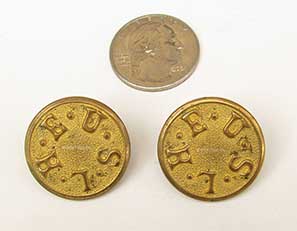 |
5.47 U.S.L.H.E. BUTTONS. A rare matched pair of authentic lighthouse keeper’s uniform buttons from the last century or earlier. These gold-washed brass buttons bear the letters “U.S.L.H.E.” in high relief on a textured background. The back of each button is marked “WANAMAKER & BROWN . PHILA PA .” They are 1 inch in diameter each and are in excellent condition. pr/89 The firm of Wanamaker & Brown was founded at the beginning of the Civil War in 1861 as “clothiers & furnishers for army, navy & state guard.” It continued through 1926. (Bruce Bazelon & William McGuinn, “A Directory of American Military Goods Dealers & Makers 1785-1915,” 1999, REF Publishing Manassas, Virginia). In 1789 the United States Lighthouse Establishment (USLHE) was created and operated under the Department of The Treasury. All U.S. lighthouses which were previously privately owned at the time were transferred to the government. The Cape Henry Lighthouse on the approaches to the Chesapeake Bay was the first lighthouse built by the USLHE. The relationship of the U.S. Lighthouse Establishment and the U.S. Lighthouse Service is commonly misunderstood. A third entity, the Lighthouse Board further confuses the designations. From 1820 until 1852 Stephen Pleasonton was the sole head of the lighthouse system. He was assigned the “care and superintendence of the lighthouse establishment” by the Secretary of the Treasury and given the title of “General Superintendent of Lights.” In 1852 the single administrator was replaced by a “Light-House Board” consisting of 9 members. But the Light-House Board did not replace the Light House Establishment in the 58 years it existed. The name “Lighthouse Service” was never an official title of the agency. In 1910 the “Bureau of Lighthouses” was created within the U.S. Department of Commerce. The term “Lighthouse Service” was the more commonly used vernacular than was “Bureau of Lighthouses.” But that name was never officially designated. Nevertheless, many structures and lighthouse implements from the “Bureau” era carry the letters “USLHS.” When the “Bureau” was created, the word “Establishment” fell out of favor, although it can be found in official documents after 1910. Summary - The term “Establishment” in referring to the system from 1789 until the creation of the Bureau of Lighthouses in 1910 is officially correct. From there on, the term “Service” is the most appropriate. |
 |
| maker |
 |
5.44 BATTLE AX. Very early 1800’s boarding ax of the type used by British and American sailors and marines during the War of 1812 period. This authentic example is made of hand-forged iron with a double blade mounted on its oak handle. The head is unmarked, measuring 7 ¾ inches in width and 2 ½ inches wide on the blades. The shank is 4 ½ inches in length. Overall the ax measures 18 ½ inches long. Good original condition exhibiting expected surface toning and oxidation, but no rust to speak of. The tapered oak handle is excellent. 985 In his landmark reference work “Small Arms of the Sea Services,” 1972, Flayderman & Co., publishers, Colonel Robert Rankin, USMC (Ret), dedicates chapter 1 to the “Battle Ax and Boarding Pike,” stating “The battle ax and boarding pike are two of the oldest personal weapons used in the naval service. Indeed, they are among the oldest of all weapons, having been used in one form or another since prehistoric times. Interestingly enough the ax and pike were used afloat for many years after they had been abandoned by fighting forces ashore. Both were wicked weapons for close combat. They changed very little in basic design from their introduction back in antiquity.” |
 |
 |
| DETAIL | REVERSE |
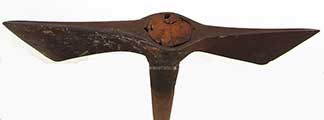 |
| BLADE |
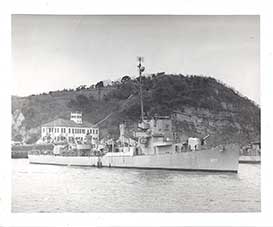 |
5.32 PERIOD WWII SHIP PHOTO. Original large format black and white image of the Buckley Class Destroyer Escort USS GEORGE (DE-697) as depicted steaming off of the Customs House in the Philippines in 1945. This clear image shows good detail of the man-o-war’s deck and armament along with crew members on the foc’sle. This valiant veteran of the Pacific campaign exhibits remarkable upkeep after all she has been through! The glossy 7 1/8 by 9 inch image is in perfect original condition. 19 The USS GEORGE (DE-697) saw intense action in World War II. Launched on August 14, 1943 by the Defoe Shipbuilding Company in Bay City, Michigan, she was commissioned on November 20, 1943 and wasted no time in heading for the Pacific theater, arriving in the Spring of 1944. During the period of May 19-31 GEORGE was credited with sinking Japanese submarines I-16, RO-104, R0-105., RO-106, RO-108 and RO-116. GEORGE continued her anti-submarine patrols in the areas in and around the New Hebrides, Solomons and Marshall Islands into the summer of 1945, operating out of the Philippines. It was then that this photograph was taken. When Japan surrendered in August of1945, GEORGE delivered the terms of the surrender to the Japanese garrisons still holding out on Truk and the Carolines. For her service, USS GEORGE received two battle stars. |
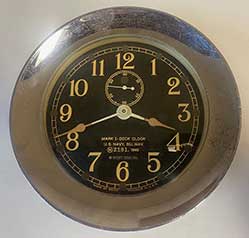 |
5.38/13.14 EARLY NAVY DECK CLOCK. Most impressive pre-war U.S. Navy clock made by the renowned American clock maker Seth Thomas as marked on the bottom of the dial “MADE BY SETH THOMAS IN U.S.A.” This massive clock has a blackened brass dial with Arabic numerals, a minute chapter and luminescent spade hands. The subsidiary seconds bit is below the 12, calibrated in single seconds marked by 10’s. The signature reads “MARK I DECK CLOCK, U.S. NAVY, BU.NAV. (N) 2191, 1940.” This indicates it was made at least a year and a half prior to America’s entry into World War II at the end of December 1941! The high quality movement met the very demanding specifications of the government at that time. It consists of an all brass, 11 jewel movement with compensated lever escapement which functions regardless of temperature and atmospheric conditions. The backplate of the movement is stamped “MADE IN (<ST>) U.S.A.” with the model number “5180.” Undoubtedly, this is one of the finest quality mechanical clocks ever made, at a time when the fate of America was on the line! The 5 ¾ inch dial is encompassed by its silvered reflector ring set in the nickeled brass bezel with convex crystal. The flared bezel is classic. It is solid brass in a nickel finish, hinged on the left, opening on the right with a pivoting wing nut. The amazing over-built brass case measures 8 ¼ inches on the mounting flange and 7 ¼ inches in diameter on the bezel. The opening to the face is 5 5/8 inches. The entire unit weighs an astounding 10+ pounds! Overall condition is excellent. There is some expected age spotting to the finish, mainly on the bezel flange. But this is entirely consistent with its age and actual use in a combat environment. The clock is an excellent timekeeper. Complete with period brass winding key. 895 In his landmark reference book, Marvin Whitney, “Military Timepieces,” 1992, American Watchmaker’s Institute, states on page 429 that Seth Thomas boat and deck clocks (Mark I) were constructed in accordance with U.S. Navy Department specifications of 1938. They consisted of an 8-day movement housed in a metal case which was dust-proof and moisture-proof. It was equipped with a cushioned bulkhead mounting plate with a lusterless black 12-hour dial with luminous hand and dots over the numerals. Each had an eccentric second hand. The clocks were designed to be wound and set and regulated through a dust cover on back of the case. The model number was stamped on the backplate. In this case it is No. 5180. |
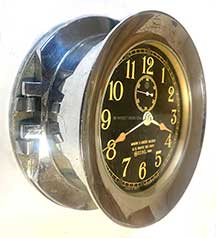 |
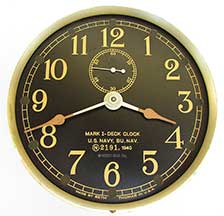 |
| perspective | dial |
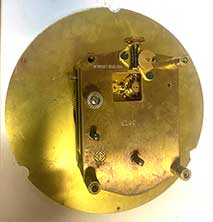 |
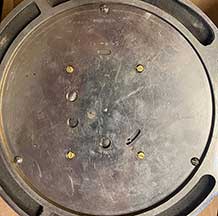 |
| movement | back |
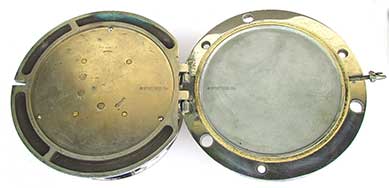 |
| backs |
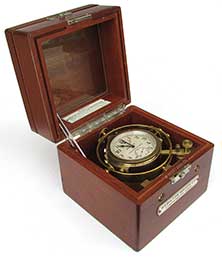 |
5.33/13.11 WORLD WAR II DECK WATCH. The famous navigational chronometer watch made for the U.S. Navy by the prestigious Hamilton Watch Company of Lancaster, Pennsylvania. This iconic timekeeper consists of Hamilton’s innovative Model 22 embodied in an oversized 35 size watch set in a very heavy solid brass case with weighted bottom. Billed as a “chronometer watch” this marvel of precision timekeeping is technically not a “true chronometer.” But what was done to elevate its timekeeping ability to that high status is remarkable. Instead of having a spring détente chronometer escapement, it has a standard watch balance known as a “lever escapement.” To maintain consistent power it contains an oversize main spring 60 inches in length! The innovative biaxial thermal expansion balance is fitted with an Elinvar hairspring unaffected by temperature changes. What’s more, this new innovation was non-magnetic! The lovely damascened nickeled brass movement is signed “HAMILTON WATCH CO. MODEL 22 – 21 JEWELS ADJ. TO TEMP. & 6 POS. MADE IN U.S.A. U.S. NAVY BU. SHIPS – 1943. It features a white enameled dial with bold Arabic numerals swept by blued steel spade hands and a minute chapter ring. A subsidiary seconds bit records single seconds marked by 10’s over the “6.” The intricate Up/Down winding indicator is below the “12.” It shows the status of winding in hours from 56 DOWN to 0 UP. This watch is stem wound and pin set. The latter is a high grade cautionary feature which prevents the time from being accidentally set during winding. Serial numbers on the bezel, on the side of the case and on the weighted brass bottom all match. The entire assembly is slung in gimbals and is mounted in its original 3-tier mahogany box with 2 original nameplates. The box measures 6 inches cubed. The overall condition is outstanding throughout. The watch itself is an excellent timekeeper. Price Request After Japan attacked Pearl Harbor, Hawaii in late 1941 America entered World War II. The Hamilton Watch Company met the navigational challenge with its famous Hamilton Model 21 and 22 chronometers. Amazingly, it produced more than 10,000 of each model to the highest standards demanded by the government. This is one of those heroic survivors which has now lasted 80 years and is still going strong! |
 |
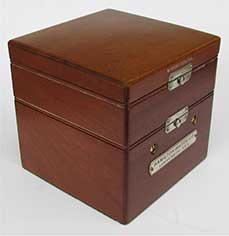 |
| front | perspective |
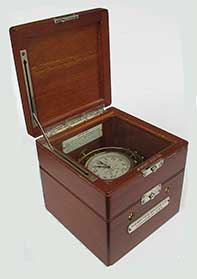 |
 |
| open | detail |
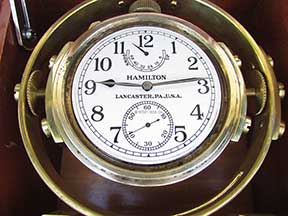 |
 |
| dial | movement |
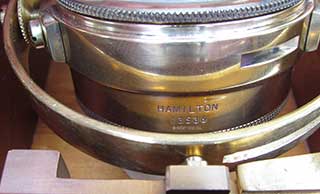 |
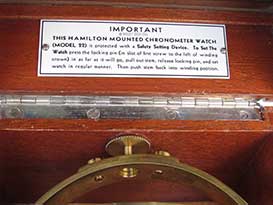 |
| hamilton | plaque |
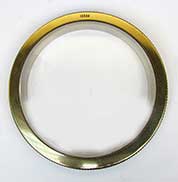 |
| bezel number |
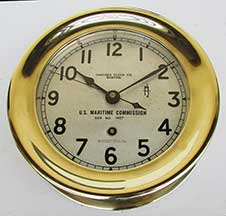 |
5.34/13.12 IMPRESSIVE WWII CLOCK. One of the finest ship’s clocks ever made, this handsome example is by the prestigious Chelsea Clock Company of Boston Massachusetts as clearly signed on the dial “CHELSEA CLOCK CO. BOSTON” below the 12. This high quality timepiece has a silvered brass dial with large Arabic numerals and a minute chapter ring swept by blackened spade hands. In a rare departure from its standard models up to that time, and in keeping with Government specifications, it bears a center sweep second hand. Under the center arbor it is boldly marked “U.S. MARITIME COMMISSION Ser. No. 1407.” The clock retains its silvered dial reflector ring, protected by the screw-on bezel with original glass and rarely-found snap ring. The all brass jeweled movement is a thing of beauty and is stamped on the backplate “CHELSEA CLOCK CO. BOSTON U.S.A. with the serial number “306XXX*” dating its production to April 1942, just 4 months after America’s entry into the War. It is housed in its original heavy solid brass case of flared classical clock case design. The screw on bezel assures an air tight fit. That back of the clock is stamped with the matching movement number “306XXX*.” Outstanding original condition in all respects. The clock has just been professionally service by a certified watch maker and keeps perfect time. It also comes with a one year warranty! 650 A nearly identical, but later clock sold in August 2023 for $819. https://www.eldreds.com/auction-lot/chelsea-ships-clock-20th-century-bezel-diameter-7_D604EBAA6B In his landmark work “Military Timepieces” by Marvin Whitney, 1992, American Watchmakers Institute Press, the author indicates that the Chelsea “Radio Room” clock became a standard inventory item in the early months of 1941 when the Navy and Maritime Commission included it in their mechanical clock specifications. This was Chelsea’s model 12E with an 11 jewel 8 day movement made in accordance with U.S. Navy Department Specifications dated September 1, 1938. *For the privacy of the buyer the entire serial number is being withheld.
The United State Maritime Commission was an independent executive agency of the U.S. federal government created by the Merchant Marine Act of 1936. It replaced the United States Shipping Board which had existed since World War I. Its purpose was to establish a merchant shipbuilding program to design and build five hundred modern merchant cargo ships to replace the World War I vintage vessels which composed most of the United States Merchant Marine at the time. Secondly, to subsidize the building of those ships in the U.S. and operate them under the American flag. From 1939 through the end of World War II, the Maritime Commission funded and administered the largest and most successful merchant shipping in world history. By the end of the war, U.S. shipyards working under U.S. Maritime Commission contracts had built a total of 5,777 oceangoing merchant and naval ships and many smaller vessels! The U.S. Maritime Commission was disbanded on May 24, 1950. |
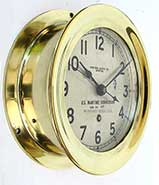 |
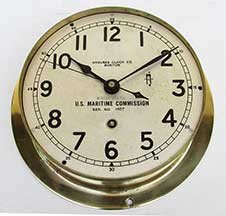 |
| perspective | dial |
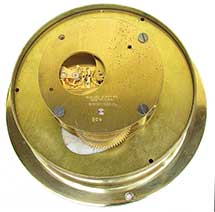 |
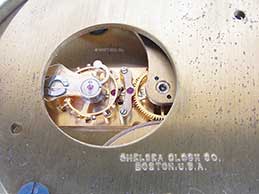 |
| movement | escapement |
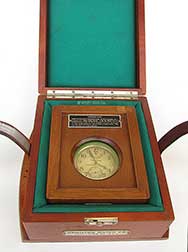 |
5.32/13.10 CELEBRATED PT BOAT WATCH. The iconic World War II U.S. Navy deck watch made even more famous by JFK’s PT-109. Incredibly, it was produced under the most demanding and trying times when America just entered the war. Billed as a “chronometer watch” this marvel of precision timekeeping is technically not a “true” chronometer. But what was done to elevate its timekeeping ability to that high status is remarkable. Instead of having a spring détente, it has a standard watch balance known as a “lever escapement.” Hamilton, already known for its production of top quality pocket and wrist watches, stepped up to the plate in the tumultuous months leading up the nation’s active involvement. This fabulous example marks a high point in the company’s long history of producing quality timepieces. It is embodied in a large 35 size pocket watch with white enameled dial. The high grade 21 jewel movement contains an oversize main spring 60 inches in length! The innovative biaxial thermal expansion balance is fitted with an Elinvar hairspring unaffected by temperature changes. What’s more, this new innovation was non-magnetic! The bold Arabic numerals are swept by blued steel spade hands within a minute chapter ring. A subsidiary seconds bit recording single seconds marked by 10’s is over the “6.” The quality Up/Down winding indicator is below the “12.” It shows the status of winding in hours from 56 DOWN to 0 UP. This watch is stem wound and pin set. The latter cautionary feature prevents the watch from being accidentally set during winding. The back of the watch has a screw-on cover. Inside it is marked “KEYSTONE Base Metal” with the company’s trademark. An inner snap-fit cover further protects the precious movement. The highly damascened nickel plates are a thing of beauty. With its state-of-the-art compensated balance it is literally an Horological work of art! The top plate is marked “HAMILTON WATCH CO. MODEL 22 -21 JEWELS ADJ. TO TEMP. & 6 POS. MADE IN U.S.A. U.S. NAVY BU-SHIPS. 1942.” The watch itself measures 2 3/4 inches in diameter and is 3 3/8 inches high inclusive of the winding stem (pendant). It is housed in its inner padded mahogany box measuring 6 by 5 by 2 inches with viewing window. The box is hinged at the back and closes securely with a button latch. It is further protected within its outer carrying/mounting box constructed of rich cherrywood. It bears the maker’s nameplate reading “HAMILTON WATCH CO. Lancaster, PA. U.S.A.” The hinged box measures 8 ¼ by 9 inches at the widest and 5 1/8 inch thick. It has another button latch for closure and a leather belt for carrying. The entire presentation is in a truly remarkable state of original preservation after 81 years! The perfect watch is an excellent timekeeper -- to the second! Price Request At the time of this posting a similar watch in much poorer condition is listed on eBay for $1,600. In his landmark reference book “The Ship’s Chronometer,” author Marvin Whitney remarks on page 201 “This 36 size, high-quality, 21 jeweled movement is an instrument of great beauty, precision and endurance. Anyone owning one of these fine chronometers has every reason to be proud of this possession.” |
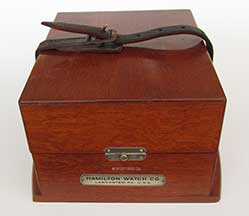 |
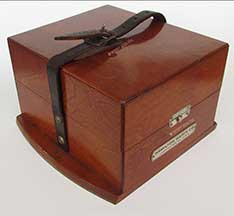 |
| outer box | outer box perspective |
 |
 |
| in case | in case 2 |
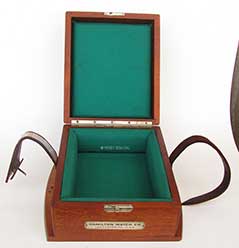 |
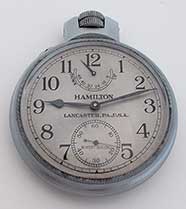 |
| outer box open | Watch |
 |
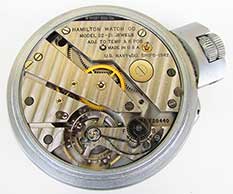 |
| covers | movement |
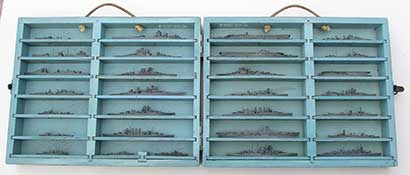 |
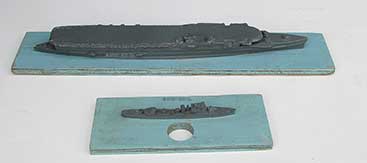 |
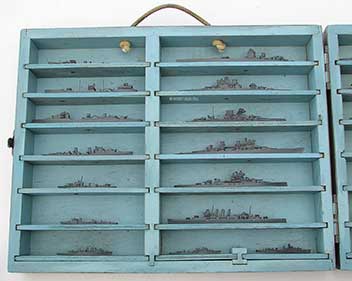 |
| comparison | left |
 |
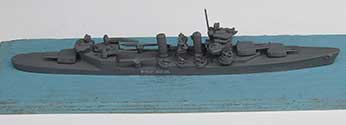 |
| right | ship 1 |
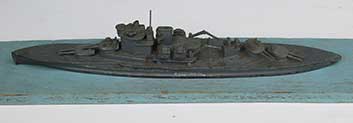 |
 |
| ship 2 | ship 3 |
 |
 |
| ship 4 | ship 5 |
 |
5.28 EARLY BOS’N PIPE. Late 19th century American boatswain’s whistle as used by sailors in the American Navy. Also known as a Bosun Pipe or Call, this whistle was hand-made of sterling silver by a gifted silversmith. To those ends the bottom of the keel is finely mortised together and is marked “STERLING.” This pipe has a large fluted mouthpiece (“mouth”) connected to a gradually tapering reed (“gun”) which terminates with the bowl. The keel retains its original lanyard attachment ring, known as the shackle. Condition is well used. The bowl was intentionally dented on both sides. This was a common practice by sailors of yore to “tune” the pipe for a proper sound. The keel is scratched with the owner’s initials, “J.M” on both sides. The gun exhibits an old repair and still produces a loud shrill sound. The entire whistle exhibits a dark age tarnish. All of these factors actually contribute to its historical appeal. 59 This whistle weighs 1 1/2 ounces. As of this writing the spot price of silver is $24 an ounce. In scrap value alone it is worth more than half our price! And this is an antique! The Call has its beginnings in the days of the English Crusades, 1248 A.D., as a method of alerting troops to arms. Documented in 1485 A.D., the call was used as an honored badge of rank, then being worn by the Lord High Admiral of England. Undoubtedly it was worn because it was used as a method of passing orders, and therefore signified authority. When the Lord High Admiral, Sir Edward Howard, was killed in action off Brest in 1513 while commanding French Galleys, a "Whistle of Honour" was presented to him posthumously by the Queen of France. From about that time onward the call was no longer used as a badge of rank, reverting to its original use as a method of passing orders only. About 1671 the name Call was well established, lasting to the present day. In the U.S. Navy the call is often referred to as a Boatswain's Pipe. |
 |
 |
| sterling | reverse |
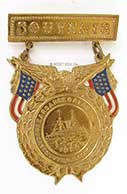 |
5.29 COMMISSIONING COMMEMORATIVE. Very rare commissioning souvenir from the USS KEARSARGE (BB-5) embossed with the inscription *KEARSARGE * ALABAMA * PORTSMOUNT N!H! SEPT. 17-20* This solid brass gold washed pin features an early style rectangular badge reading “SOUVENIR” which suspends a spread-winged American eagle flanked by colorful cloisonné American flags. The eagle is perched on a wreath encircling a very detailed image of the battleship above the date “1900.” The back bears the entire text of the Lord’s prayer encircled within a heart. The bottom is signed “C.M.ROBBINS. MAKER. ATTLEBORO, MASS.” 2 ¼ inches tall and 1 3/8 inches wide. Condition is “as new.” Absolutely extraordinary after 120+ years! 149 The pre-dreadnaught American battleship USS KEARSARGE (BB-5) was launched on March 24, 1898 and commissioned on February 20, 1900. She was the only American battleship not to be named after a state. After commissioning she served as flagship of the Atlantic Fleet into 1905. From 1907-1909 KEARSARGE sailed around the world as part of the Great White Fleet. She served in the Atlantic between 1916 and 1919 as war raged in Europe. Converted into a crane ship 1920, she was renamed Crane Ship No. 1 in 1941. She continued her service, handling guns, turrets, armor, and other heavy lifts for vessels such as INDIANA, ALABAMA, SAVANNAH, CHICAGO and PENNSYLVANIA. She was decommissioned in San Francisco at the end of World War II and sold for scrap in 1955. See item 5.11 |
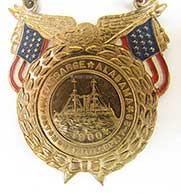 |
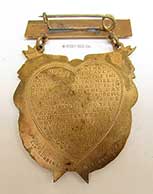 |
| detail | back |
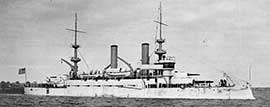 |
| ship |
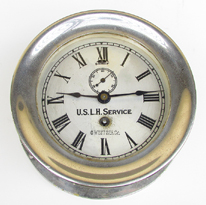 |
5.22/13.09 U.S. LIGHTHOUSE SERVICE CLOCK. Genuine, early 1900’s clock from an identified lighthouse! This handsome little clock was made by the prestigious Chelsea Clock Company of Boston, Massachusetts and is marked “CHELSEA BOSTON” at the bottom of the silvered brass dial. The dial is encircled by a minute chapter ring and is marked with bold Roman numerals swept by blued steel spade hands. The Fast/Slow adjustment and the subsidiary seconds bit are below the XII. The bit shows single seconds marked in increments of 10. The clock retains its original silvered reflector ring covering the periphery of the dial. The high quality jeweled movement is marked “BOSTON CLOCK CO. BOSTON U.S.A. with the serial number 278XX B*. This is Chelsea’s innovative Boston movement which featured a miniaturized 7 jewel timekeeper with non-corrosive nickel plates. It is mounted in its very heavy nickel-plated brass case with classic flared screw-on bezel containing its original wavy crystal glass and retaining wire. The back of the case is stamped with the matching movement number “278XX.”* The clock measures 5 5/8 inches in diameter and is 2 ½ inches deep. Outstanding original condition keeping excellent time after more than 90 years. Complete with original old “bat wing” Chelsea winding key. Price Request * For the privacy of the ultimate owner the complete serial number is being withheld. According to Andy Demeter in his groundbreaking reference book “Chelsea Clock Company, The First Hundred Years,“ 2001, Demeter Publications, Chelsea, Massachusetts, the Chelsea Company produced Boston Clock movements from about 1914 through 1930 and dated this clock to circa May 10, 1922. But in his 2nd Edition Demeter indicates this exact clock, serial “278XXB,” was delivered to the U.S. Lighthouse Service on July 29, 1932. We cannot account for the discrepancy in dates, but the 10 year timeframe is certainly consistent with the date of the Lighthouse Service and the lighthouse in which it served. According to the party from whom we acquired this clock, it came from an old Bellingham, Washington estate. Ships heading from Bellingham Bay through the Straits of Juan de Fuca passed Burrows Island, where strong eddies and rip tides made passage unpredictable. In 1897 the Lighthouse Board noted that vessel traffic through the Strait was increasing. In response to the need it requested $15,000 to build a light and fog signal on the south west point of Burrows Island -- a point of departure for vessels plying the strait. Congress approved construction of the Burrows Island Lighthouse in 1903. The shoreline of Burrows Island is primarily sheer steep rock. Steep hills covered with evergreens and grass cover much of its interior. The light station was built on one of the few level spots on the island’s shoreline. Work began in May 1905 and the wooden frame lighthouse was first lighted on April 1, 1906. It had a white light with a red sector shown from a 4th order Freznel lens The station originally included the combination light tower and fog signal building, the keeper's quarters, oil house, a boathouse and a derrick. Burrows Island Lighthouse was automated in 1972 when the final Coast Guard personnel left the station. The boathouse and keeper's dwelling were boarded up and a fence erected. In the early 1990's a modern optic replaced the Freznel lens in the lantern room. Today the complex is still standing as an historical site. During its service as the Burrows Island Lighthouse the keepers were: James B. Hermann (1906), Eugene M. Walters (1907), Edward Pfaff (1907), William J. Thomas (1907 – 1913), Thomas J. Stitt (1913 – 1920), William Dahlgren (1920 – at least 1921), Daniel W. Clark (1924 – 1931), Robert R. Bay (1931 – 1932), John T. O’Rourke (1932 – 1943), Richard Johnson (1960 – 1963), Frank Showers (at least 1966), David J. Grotting (1969 – 1972). In 1789 Congress passed an Act creating the United States Lighthouse Establishment (USLHE) which was operated by the Department of the Treasury. The Act also transferred ownership of all existing private American lighthouses to the U.S. government. In 1852, the United States Lighthouse Board was created. The Act dissolved the prior administration of lighthouses under the Treasury Department's Lighthouse Establishment. The board consisted of six senior Naval officers governing 12 lighthouse districts, each having a Naval inspector who was charged with building lighthouses and maintaining their good working order. The Lighthouse Board immediately set to installing state-of-the-art Freznel lenses in all newly-built lighthouses. The Board also oversaw the construction of the first lighthouses on the West Coast. By the Civil War, all U.S. lighthouses had Freznel lenses. In 1886, electricity was tested to illuminate the Statue of Liberty. Thereafter the lighting of the statue was the Lighthouse Board's responsibility. It remained such until 1902, when the "modern age in lighthouse illumination" began. In 1900, the Lighthouse Board started converting lighthouses to electric service. In 1910, the Board was changed in favor of a civilian run "Lighthouse Service." It is uncertain as to exactly when the U.S. Lighthouse Establishment became the U.S. Lighthouse Service. Both terms for the agency appear to have been used interchangeably in the second half of the 19th century. In 1939 the U.S. Lighthouse Service itself was disbanded and merged with the U.S. Coast Guard. |
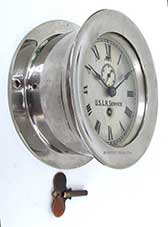 |
 |
| perspective | dial |
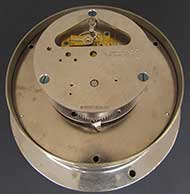 |
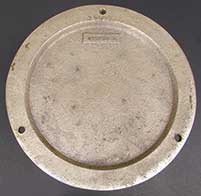 |
| movement | back |
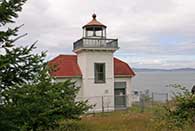 |
| lighthouse |
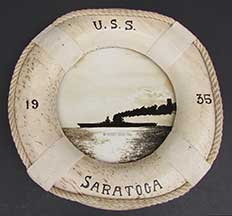 |
5.27 COMMEMORATIVE LIFERING. Sailor folk art in a wooden lifering frame containing an original photograph of the USS SARATOGA (CV-3). The clear, period photo is from an early silver negative. It shows the ship underway at a high speed belching black coal smoke. The old photos housed under its original old wavy glass and measures 3 ½ inches in diameter sight. The lifering is hand-painted “U.S.S. 19 35 SARATOGA.” It is encircled on the perimeter with a traditional woven cotton “grab line” held by 4 cotton swatches. It measures 6 inches in diameter. The condition is excellent, noting some discoloration on the back -- an indication of good age. An historic relic from the earliest days of Naval aviation in America. 339 The USS SARATOGA was a LEXINGTON class aircraft carrier built for the United States Navy during the 1920s. Originally designed as a battle cruiser, she was converted into the Navy's first fast aircraft carrier. She was launched by the New York Shipbuilding Corporation in Camden, New Jersey on April 7, 1925 and commissioned on November 17, 1927. The ship entered service in 1928 assigned to the Pacific Fleet. SARATOGA and her sister ship LEXINGTON worked feverously in excercises to develop aircraft carrier tactics in anticipation of war. When the Japanese attacked Pearl Harbor on December 7th, 1941 SARATOGA was one of three prewar aircraft carriers, including ENTERPRIZE and RANGER, to be absent from the attack. Shortly afterwards SARATOGA participated in the unsuccessful effort to relieve Wake Island from Japanese occupation. In that effort she was torpedoed which led to extensive repairs. She went on to participate in the Guadalcanal campaign in August 1942 when her aircraft sank the Japanese carrier RYUJO. But in that campaign she was again torpedoed and required further repairs. In 1943 SARATOGA participated in the invasion of Bougainville in the Solomon Islands and in November her aircraft twice attacked the Japanese base at Rabaul. In early 1944 she provided air support for the Gilbert and Marshall Islands campaigns. Thereafter she was transferred to the Indian Ocean to support the British Eastern Fleet during its attacks on Java and Sumatra. A necessary refit in mid-1944 carried the ship into early 1945. In February SARATOGA participated in the Battle of Iwo Jima where she was badly damaged by Kamikaze hits, forcing her to return to the States for major repairs. While in drydock it became obvious that the aging ship had become obsolete. Accordingly, she was modified to become a training ship and much of her hangar deck was converted into classrooms. SARATOGA remained in that role until she was assigned to ferry troops back to the United States after Japan’s surrender in August 1945. In mid-1946 the venerable old lady was made a target ship for nuclear weapons testing during Operation Crossroads. She survived the first test with little damage, but was sunk by a second test on July 25, 1946. SARATOGA received 8 battle stars for her active roles in World War II combat. |
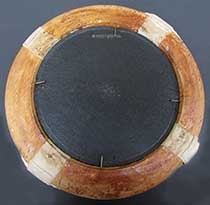 |
| back |
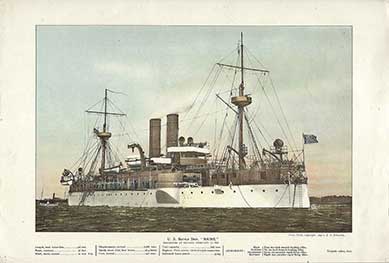 |
1.91/5.24 ORIGINAL BATTLESHIP MAINE LITHOGRAPH. Authentic, period stone chromolithograph of the immortal American Battleship U.S.S. MAINE, certainly one of the most famous battleships in American Naval history. This vivid high quality color image depicts the ill-fated ship at anchor from a starboard quarter perspective in happier times. The detail is exceptional and bears close scrutiny under magnification. It reveals many ship details including several sailors on the main deck as produced from an original copyrighted photo dated 1896. The bottom of the image contains extensive information on the ship’s characteristics and armament. This is NOT a modern dot matrix reproduction, nor is it a page from a book. It was printed in large format for singular display. With full margins it measures 8 ½ by 12 ½ inches. Outstanding original condition. Very worthy of framing. 59 The explosion and sinking of the Battleship MAINE (ACR-1) in Havana Harbor on February 15, 1898 with the loss of 260 American lives, led to America declaring war on Spain. On April 23rd, after much Yellow Journalism and political wrangling, Congress declared that a state of war had existed between the U.S. and Spain since April 21, the day the U.S. began to blockade Cuba. In the ensuing 10 weeks U.S. Naval and land forces thoroughly decimated Spanish forces. It was during this period that the vast majority of "Remember the Maine" articles of all types were offered to the American public in an effort to gain popular support for the war. This image predates the sinking. Subsequently, with resounding defeats in Cuba and the Philippines, Spain sued for peace. Hostilities were halted on August 12, 1898, when a Protocol of Peace between the United States and Spain was signed in Washington. The formal peace treaty was signed in Paris on December 10, 1898. As a result of the war the United States gained all of Spain's colonies outside of Africa, including the Philippines, Guam and Puerto Rico, excepting Cuba which became a U.S. protectorate. These gains prompted John Hay, America's Ambassador in Britain, to refer to it in a letter to his friend Theodore Roosevelt as "the splendid little war." Theodore Roosevelt and George Dewey benefited greatly from their participation in the war. Both men gained immediate fame as national heroes. Roosevelt's fame ultimately propelled him to the White House. |
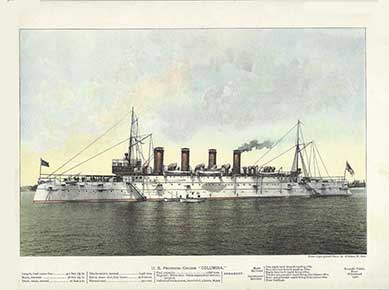 |
1.90/5.17 PERIOD NAVAL LITHOGRAPH. A fine, stone lithograph taken from an original photograph of the “U.S. Protected Cruiser COLUMBIA” as entitled at the bottom. This especially clear portside view of the late 1800’s state-of-the art fighting ship shows her at anchor with her boats alongside. She flies the Jackstaff at the fore and the American ensign at the stern. One of the 4 imposing smokestacks belches coal smoke. The colorful image it is signed “From Copyrighted Photo by William H. Ran.” Below this is detailed information about the ship’s characteristics and armament. Full margins. 12 ¼ by 8 ¼ inches. Outstanding state of original preservation after more than 120 years! 39 The USS COLUMBIA (C-12) was the 4th ship in the U.S. Navy to be named after the city in South Carolina. She was built by the William Cramp Shipyard in Philadelphia and launched on July 26, 1892 and commissioned on April 23, 1894. Her distinctive 4 smokestacks assured her place in history as a transitional steam warship from the 1800’s. But at that time, even as a steamship, she was still classified at a sailing schooner with 2 masts! COLUMBIA joined the North Atlantic Squadron in1894 and visited Europe in 1895 to represent the United States at the opening of the Kiel Canal in June. Returning home, she was placed in reserve in May of 1897. Recommissioned on March 15, 1898 for service in the Spanish–American War, COLUMBIA patrolled the Atlantic coast and West Indies until late August. She carried American troops to Puerto Rico and participated in America’s occupation in July and August. She was decommissioned and placed in reserve at Philadelphia Navy Yard in March 1899. Recommissioned in August 1902, COLUMBIA, was the receiving ship for the Atlantic Training squadron. In anticipation of World War I she was the assigned the stature of Submarine Flotilla flagship and was detached to patrol the Delaware Breakwater in April 1917. In July she joined the Cruiser Force Atlantic and escorted troops of the American Expeditionary Force to France. In July she joined the Cruiser Force as a convoy escort. In that capacity, between January and November 1918, she made five Atlantic crossings. In January 1919, she became flagship of Squadron 2 Destroyer Force Atlantic, operating on the East Coast and the Caribbean. She was relieved of that duty in May and was decommissioned at Philadelphia Navy Yard June on June 29, 1921 Reclassified as CA-16 on July17, 1920, she was renamed OLD COLUMBIA and was struck from the Naval records on June 21, 1922. |
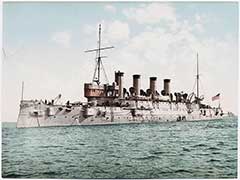 |
| photo |
 |
5.13 LIGHTHOUSE PLAQUE. Very scarce, highly collectible identification plaque taken from the mechanism used to rotate the lens in a lighthouse. This very scarce original lighthouse relic is from an American lighthouse reading “OLD BOARD + LIGHT.” It is engraved solid brass measuring exactly 5 inches in length and 1 inch wide. Excellent, original as taken condition. A seldom seen U.S.L.H. Service relic. 99 Lighthouses of the 1800’s into the early 1900’s had complex mechanical apparatus which rotated their precious lenses at a published, pre-determined speed for extended durations. A key requirement of a lighthouse light was its visibility and “period” which enabled mariners to locate it and positively identify their location. In the early days before electricity this was accomplished using heavy machinery. The largest lighthouse lenses weighed tons. Movement was driven by clockwork mechanisms much like those found in tower clocks. This label was part of such an apparatus. |
 |
| back |
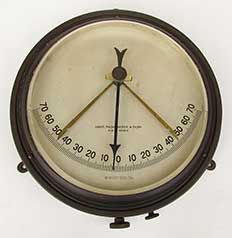 |
5.35/8.89 EARLY U.S. NAVY INCLINOMETER. Very rare surviving example of a large ship’s pilot house clinometer which saw service aboard a World War I U.S. Navy warship. This handsome all brass instrument is absolutely premium quality. It has a fine silvered brass dial which boldly displays the ship’s roll ((heel) in single degrees up to 70 port and starboard marked by 10’s. The dial is signed by the maker “Graff, Washbourne & Dunn, New York.” The complicated internal mechanism consists of a heavy pendulum bob connected to its outer indicator needle which sweeps over the appropriate degree scale. On either side are 2 brass arms which mark the extent of travel of the needle – the maximum roll encountered. To reset the arms a knurled brass knob rove though the glass moves them back to center. At the bottom of the instrument is another large knob which can be turned to lock the bob in place when not in use. To its right is a second smaller spring-loaded knob. Pressing it dampens (stops) the movement of the pendulum. This ingenious device has an 8 inch dial protected by a lovely thick beveled glass crystal. The entire instrument is 9 ¼ inches wide and 2 ¼ inches thick. The back is distinctively engraved “U.S. NAVY [N] 899.” Remarkable original condition. A real rarity over 100 years old! This is the first such identified U.S. Navy inclinometer we have ever encountered in our 40+ years. 785 Graff Washbourne & Dunn were preeminent silversmiths in America at the turn-of-the-century. A distance reading “stadiometer” dating to World War I, manufactured by Gaff, Washbourne & Dunn, circa 1917 is held in the collection of the NMAH (Smithsonian). Leading up to its involvement in the Great War America’s armed forces were woefully ill equipped to fight a global war. This fact was particularly acute in the U.S. Navy. As the Navy Department, under direction of the Secretary of the Navy, Franklin D. Roosevelt, scrambled to outfit its warships, the call went out to the civilian sector to provide (purchase or loan) all manner of equipment to enhance readiness at sea. The patriotic response was overwhelming. One such example is this inclinometer which bears the engraved Navy serial number “U.S. NAVY [N] 899.” A goodly number of loaned items were returned to their owners after the War together with a letter of thanks personally signed by FDR. |
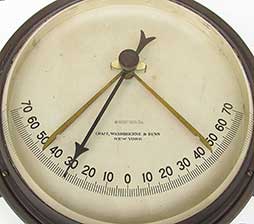 |
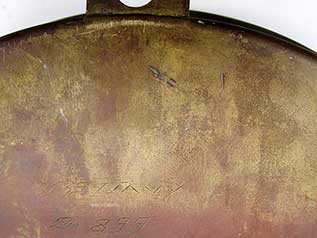 |
| inclined | u s navy |
 |
| back |
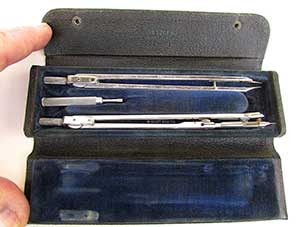 |
5.31 WWII NAVIGATOR’s SET. Scarce, genuine cased navigational tools used by the Navigation Officer of a U.S. Navy warship in the early 1940’s. This high quality set is mounted in its original black leather case with dark blue velvet liner. The top of the case in embossed in gold ”NAVIGATOR’S CASE U.S. NAVY.” It contains two very high quality drafting instruments: one a divider and the other a pencil lead compass. These precision instruments are made of solid brass in a chrome finish and are stamped “DIETZGEN - MADE IN U.S.A.” The case also contains a knurled screwdriver for adjusting the instruments. And it has the clever dual function of also being a container for spare needle points and pencil leads for the instruments! The case measures 7 ¾ inches long by 2 ¼ inches wide and is 1 inches think. Virtually perfect, mint condition scarcely evidencing its 75+ years of service. The first of its type we have ever seen in such superb condition. 189 |
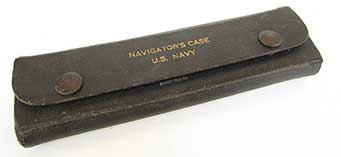 |
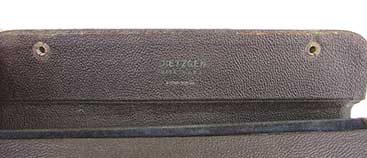 |
| case | case mark |
 |
| maker |
 |
3.14/5.46 U.S. NAVY CLINOMETER. Authentic World War II fighting ship's pilot house inclinometer made for the Navy by the John L. Chaney Instrument Company. The face of the Bakelite body is engraved: CLINOMETER
U.S. NAVY BU-SHIPS MK IV 1943 JOHN L. CHANEY INSTR. CO. LAKE GENEVA WISC., U.S.A. This precision device is calibrated in single degrees of heel port and starboard up to 70 marked by 10's. The reading is made by a small black ball within a curved glass tube containing fluid. The fluid acts to dampen (slow) the ball as the ship rolls. This is exactly the same principle used in an aircraft's turn and bank indicator. The instrument measures 12 ½ inches wide by 6 ¼ inches high. It is in excellent original condition. The action of the ball is perfect. 395 |
 |
| back |
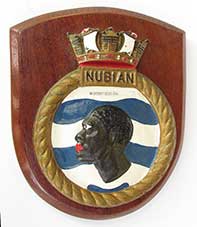 |
5.30 FAMOUS WWII SHIP’s PLAQUE. Authentic World War II Royal Navy Ship’s plaque commemorating the HMS NUBIAN (F-36). This very unusual ship’s commemorative features a cast aluminum shield bearing the likeness of a black African surrounded by a gold painted “rope” border surmounted by the Admiralty’s distinctive crown and the banner “NUBIAN.” The hand-painted plaque is mounted to a lovely solid mahogany shield backboard backed by “baize” cloth. The plaque is 4 2/4 inches in diameter. The backboard measures 5 ¾ inches wide by 6 ¾ inches tall. Outstanding original condition in all respects. Very rare! 195 HMS NUBIAN (F-36) was a Tribal Class destroyer of the Royal Navy launched on December 21, 1937. She had a length of 377 feet and displaced 1891 tons. This war hardened ship had an illustrious career in the North Atlantic and Mediterranean during World War II. Only two other ships, the ORION and JERVIS, also serving in the Mediterranean with NUBIAN, matched her battle record. In British Naval history these records were exceeded only by the Battleship WARSPITE in World War I! |
 |
 |
| back | ship |
5.21/13.01 IMPORTANT CLOCK from U.S. NAVY MONITOR. Extremely rare, identified engineroom clock from the American Naval monitor the U.S.S. TERROR. This imposing timekeeper is made of heavy solid bronze. The early form pressed copper dial is silvered with bold Roman numerals and a minute chapter ring. The ship's name USS TERROR is prominently engraved just below the center arbor. The case maker's name "ASHCROFT MFG CO. New York" is just below. At the top, below XII is the Fast/Slow adjustment and below it is the subsidiary seconds bit indicating single seconds marked by 15's. The dial is swept by large blued steel Breguet style "moon" hands. The silvered dial shows some authentic wear. The word "ENGINE ROOM" is stenciled on the dial -- faint but still visible. Importantly the dial is original and has not been retouched or modified. The classic flared ship's clock case is hinged on the left, opening to the right, closing on a skeleton key lock which retains its original key. The mechanism is the best ship's clock ever made in America by the Howard Clock Company of Boston. It features a bi-metallic balance, 11 jewels, 8-day spring barrel and lovely damascened nickel plates. It is signed "E. Howard & Co. Boston" and is serial numbered "17." The very low number indicates it was one of the first ship's clocks ever produced by Howard, soon after the Civil War. The massive solid bronze case, produced by the Ashcroft Steam Gauge & Valve Co. has an 8 1/4 inch dial and a case flange of 10 ¾ inches, It measures 4 inches deep and weighs an impressive 15 pounds! It is in excellent original condition and is a strong runner after 150 years! USS TERROR (BM-4) TERROR was an AMPHITRITE class monitor with twin screws and double turrets. She displaced 3,990 tons with a length overall of 263 feet, a beam of 55 ½ feet and a draft of 14 feet 8 inches. In 1874, nine years after the Civil War, President Ulysses S. Grant ordered it built. The contract was awarded to the William Cramp & Sons Shipyard in Philadelphia, a major builder of U.S. Navy ships at that time. Work halted in 1877, but began again 6 years later. The reasons for the delay were two fold. Firstly, there was no foundry in the United States capable of producing the heavy armament specified in the ship's plans. Secondly, advancements in Naval architecture were progressing so rapidly that innovations in design were overtaking the original obsolete specifications. Still unfinished, the massive warship was towed to the New York Naval Yard for completion. On April 15, 1896 USS TERROR was finally commissioned. Assigned to the North Atlantic Squadron, TERROR operated up and down the East Coast. When the Battleship MAINE exploded in Havana Harbor on February 15, 1898 TERROR was dispatched to Key West, Florida, arriving on April 2nd. On April 25th the United States declared war on Spain. On the very first day of hostilities TERROR captured the Cuban vessel ALMANSAS. In the following 2 days the monitor captured the Spanish ships AMROSIA BOLIVAR and GUIDO. On May 12th Admiral Sampson's squadron began bombarding the Spanish batteries at San Juan, Puerto Rico. TERROR, the fifth ship in the column, fired 31 ten inch shells in 3 salvos, scoring a direct hit on the shore battery. For the remainder of the war TERROR cruised the West Indies and the waters off Puerto Rico. Into the early 1900's TERROR served as a training ship for midshipmen at the U.S. Naval Academy. She was ultimately decommissioned on May 8, 1906 and scrapped sometime in early 1930. Edward Howard (1813-1904), apprenticed to the famous early American clock maker Aaron Willard, Jr., began his own manufacturing in Boston in 1840. His firm was known as the E. Howard Co. until 1881. The first clocks known as "marine clocks" made their appearance around 1860. All of Howard's movements were very well made. The Howard model 69 marine/locomotive clock had 11-jewels with plates of heavy brass, nickel plated and highly damascened. (Marvin Whitney, "Military Timepieces," 1992, AWI Press). Interestingly, the back of the dial of this clock is etched "U.S.S. Santee Feb 14, 1902." SANTEE was a sailing frigate of 44 guns commissioned on June 9, 1861. After active service in the Civil War SANTEE became the major training ship at the U.S. Naval Academy, Annapolis, Maryland for decades. On April 2, 1912 SANTEE sank at her mooring. The relationship between TERROR and SANTEE is unclear. More fascinating research will prove valuable. |
 |
 |
perspective |
dial |
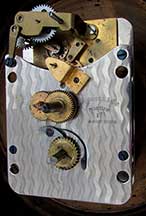 |
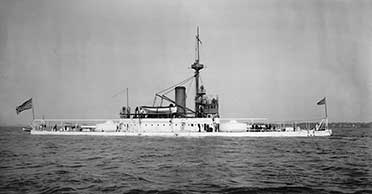 |
movement |
ship |
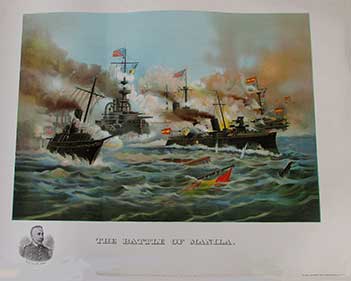 |
1.84/5.15 SPANISH-AMERICAN WAR GROUPING. Three genuine historically important items directly pertaining to the war fought between the United States and Spain in 1898. They are:
The explosion and sinking of the Battleship MAINE (ACR-1) in Havana Harbor on February 15th, with the loss of 260 American lives, led to America declaring war on Spain. On April 23rd, after much Yellow Journalism and political wrangling, Congress declared that a state of war had existed between the U.S. and Spain since April 21, the day the U.S. began to blockade Cuba. In the ensuing 10 weeks U.S. Naval and land forces thoroughly decimated the Spanish. |
 |
 |
photo |
detail |
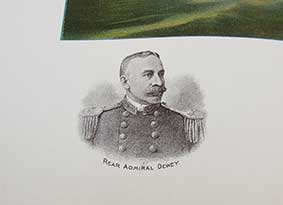 |
 |
dewey |
title |
 |
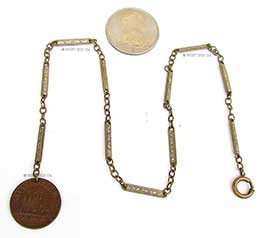 |
print |
fob |
 |
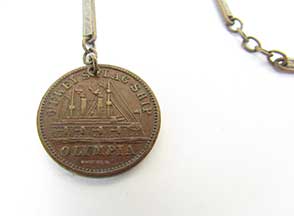 |
dewey 1 |
olympia |
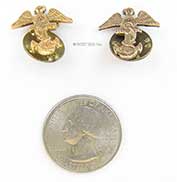 |
5.20 NAVY COLLAR DEVICES. Matched pair of collar insignias for a 1st Class Midshipman in the United States Navy. They consist of right and left facing eagles perched on a fouled kedge anchor. The back of each is marked "HP 1/20 10KT GF." ¾ inch tall by ¾ inch wide. Perfect original condition. Approximately 50 years old. 19.95/pr |
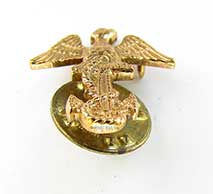 |
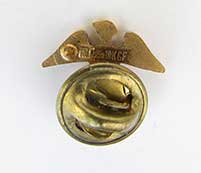 |
detail |
back |
Order Info
 |
5.16/13.02 RARE AMERICAN CHRONOMETER. A scarce surviving example from a very limited production of full-sized ships' chronometers produced for the U.S Navy by the most prestigious American clock & watch company during World War II. This amazing relic is Elgin's Model 600. The silvered enameled dial is serial numbered (N) 610 dated 1943 within the seconds bit over the "6." It has bold Arabic numerals swept by blackened spade hands over a minute chapter ring. The 56 hour Up/Down is below "12" marked in 8 hour increments. The dial is signed "ELGIN U.S.A." just above the center arbor. It is surrounded by the silvered reflector ring under a beveled glass crystal set in its knurled brass bezel. Built to exacting Navy specifications the brass bowl with gimbal lock is mounted in its gimbals slung in a rich brass-bound mahogany box of classic 3-tier construction. The magnificent nickeled brass movement has 14 jewels with a large bi-metallic balance wheel, 6 timing weights and the state-of-the-art Guillimane hairspring. The unusual two-part balance bridge has a diamond end stone. The top plate is beautifully engine turned and is engraved "ELGIN 600 U.S. 14 JEWELS U.S. NAVY BU-SHIPS (N) 610, 1943." This machine is fitted with Elgin's fusee drive and innovative detachable escapement – a first in chronometer manufacturing. The handsome fully brass-bound mahogany box is equipped with 2 sliding button latches and bears the unique Elgin corking instructions on the brass plaque in the middle tier. The bottom section has folding brass drop handles for carrying. The chronometer itself measures almost 5 inches in diameter. The box measures 7 ½ inches square by 8 inches high. Condition is nothing short of remarkable in ALL respects. This chronometer shows no signs of being used since it was manufactured 79 years ago! Perfectly preserved, factory MINT original condition! ATTENTION COLLECTORS! You will not see this type of offering again! Elgin's number 1 chronometer is in the Smithsonian Institution.Price Request Marvin Whitney in his monumental reference book, "Military Time Pieces." 1992, American Watch Makers Institute, devotes an entire chapter to "Ship's Chronometer Elgin." In it he writes, "Shortly after the attack on Pearl Harbor, the Elgin National Watch Company devoted their entire production facilities to the war effort. When the United States entered into World War II, our source of marine chronometers from Switzerland was immediately cut off. Up until that time, the world navies depended upon Swiss and English manufacturers. The Hamilton watch Company was the first to produce a ship's chronometer that met Navy specifications. In order to prevent a recurrence of the critical shortage, Elgin was awarded a contract in 1943 for 3,000 chronometers. On February 15, 1944 Elgin delivered their prototype chronometer to the Naval Observatory. The last shipment of chronometers was received on May 31, 1945. Shortly thereafter the war ended. None of the Elgins were ever issued." In November 1956 Elgin reported it had sold approximately 250 of their model 600 marine chronometers to the public. In consideration of the fact that Hamilton made more than 12,152 Navy-type chronometers (as affirmed by serial numbers of recent sales) or a ratio of more than 50:1, this Elgin example is definitely a rarity in the realm of Navy chronometers! |
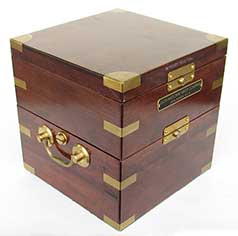 |
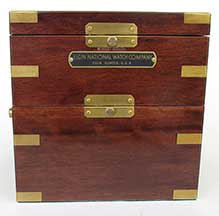 |
BOX |
FRONT |
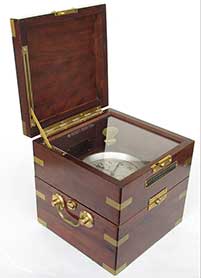 |
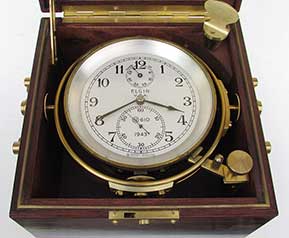 |
OPEN |
IN BOX |
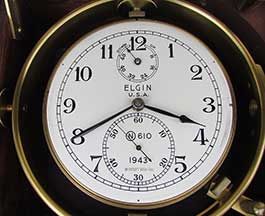 |
 |
DIAL |
MOVEMENT |
 |
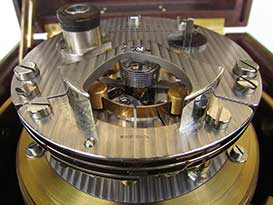 |
FUSEE |
BALANCE |
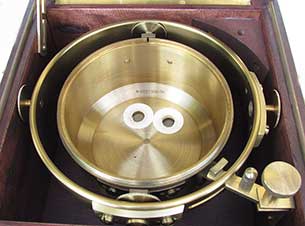 |
BOWL |
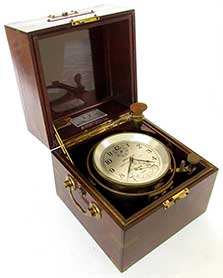
|
5.06 /13.98 U.S. NAVY CHRONOMETER. Genuine state-of-the-art full size World War II marine chronometer developed for the U.S. Navy by the "Hamilton Watch Co. of Lancaster, PA., U.S.A." as marked on the dial and on the box nameplate. This 85 size timepiece has a silvered brass dial with bold Arabic numerals and minute chapter swept by black enameled spade hands. The subsidiary seconds bit is over the "6" showing individual seconds marked by 10's. The 56 hour Up/Down indicator is below the "12." The serial number "(N)1356" and date "1941" are within the seconds bit. The heavy knurled brass bezel with thick beveled glass has a silvered reflector ring. It screws onto the solid brass bowl slung in gimbals. A spring loaded rotating dust cover protects the winding arbor. The pristine nickel movement is beautifully damascened bearing the signature "MODEL 21 14 JEWELS HAMILTON WATCH CO. LANCASTER, PNNA. MADE IN U.S.A. (N) 1356-1941." It features an oversize balance with 12 timing weights and innovative helical Elinvar hairspring. It has a spring détente escapement and a chain-drive fusee. The box is Hamilton's standard 3 tier type made of rich mahogany, fully brass-bound with inland corners in its original finish. The sides are equipped with folding brass handles and the top 2 tiers have brass button latches for secure closure. The entire unit is in untouched original condition. All brass surfaces are original showing good expected exposure to their marine environment. The surfaces of the wood are in excellent, unmarred finish. The chronometer measures 5 inches in diameter. The box is 7 5/8 inches cubed. Complete with original ratcheted winding key. An excellent time keeper. |
box |
open |
in box |
dial |
balance |
movement |
maker |
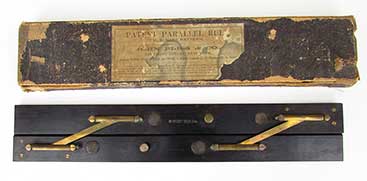
|
3.88/ 5.04 PATENT NAVY PARALLEL RULES. Rare 4th quarter of the 19th century navigator's parallel rulers made by John Bliss and Co., in accordance with LCDR Sigsbee's patent. This beautifully preserved set is made of ebony with brass fittings. It is uniquely constructed in such a manner so as to allow the limbs of the instrument to fold over the chart and align at a distance from the indicated course. This allowed the navigator to "hop scotch" across the chart without sliding the rules over the map's surface. The upper rule is stamped "PAT. FEB.24' 80." Remarkably, it is preserved within its original cardboard box with label reading "PATENT PARALLEL RULE U.S. NAVY PATTERN JOHN BLISS & CO., Under Patent granted Feb. 24 to Liuet-Comdr, C. D. Sigsbee U.S. NAVY." The rules are in absolutely perfect original condition measuring 15 inches long by 2 5/8 inches wide. The original box is 15 ¼ inches long by 3 inches wide and ½ inches thick. As expected the box shows considerable wear after 140 years. But the label with minor losses is still legible. 395 An identical Patent Rule sold for $850.00 from Tesseract catalog 94, item 40 spring of 2012. |
positioned |
rules |
patent |
label |
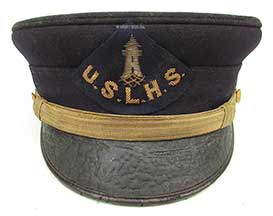
|
5.01 LIGHTHOUSE KEEPER's HAT. SCARCE! Genuine late 19th century uniform hat of an official keeper in the United States Lighthouse Service. This extremely scarce Lighthouse Service relic is made of wool with an inner body of leather and a silk liner. The classic U.S.L.H. Service emblem of a stately lighthouse on the front of the hat is hand-embroidered in gold brocade. The gold chin strap above the leather bill is attached with gilt hat buttons depicting the identical lighthouse motif. The cap is about a size 7. The top measures 8 ¾ inches in diameter. Front to back with the embossed leather bill it is 9 ½ inches. Excellent, original condition exhibiting wear with real time use expected of an authentic item worn in the pursuit of daily lighthouse chores. Over 120 years old! No damage. Very presentable original condition. Truly museum quality. SOLD |
side |
inside |
hat band button |
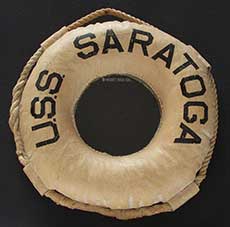
|
5.89 HISTORIC LIFERING. Authentic sailor-made life preserver frame commemorating the famous American aircraft carrier the "U.S.S. SARATOGA" as boldly hand-painted painted on the ring. This preserver is realistically made in the manner consistent with the period having a kapok core covered in hand-stitched canvas. A cotton "grab line" encircles the ring. The center is inset with original old wavy glass held in by putty. The ring is 10 ½ inches in diameter and 2 ¼ inches thick. It is in excellent condition showing its age. Interestingly the bottom of the grab line has an old hand-sewn repair of light canvas. 795 On July 1st, 1946 SARATOGA was one of a number of target ships anchored near the Bikini Atoll for nuclear weapons testing in Operation Crossroads. She survived the first test with little damage, but was sunk during the second test on the 25th. |
detail |
back |
ship |
explosion |
three carriers |

|
5.86 VERY, VERY RARE U.S. NAVY BATTLESHIP COFFEE POT! An amazing relic from an American Naval ship-of-the-line dating to World War II. These pots certainly first saw service after the Civila War, during the Spanish-American War, and cruised aboard the Great White Fleet around the globe in the very early 1900's. This later example's bottom is marked "Reed & Barton" with the letters "U.S.N." The inside of the pot contains an insulating porcelain liner which is in perfect original condition. Still usable! The bottom is signed "REED & BARTON 67627 U.S.N." with the company's Roman fasces logo dating it to 1943. According to a noted Naval historian only 48 of these "special coffee pots" were ever produced for the Navy by Reed & Barton, Wilcox and Wallace silver plate companies from the late 1870's. All were made for captains of capital ships (battleships) and Admirals' messes. One such pot, now in the collection of the Naval History Museum at the U.S Naval Academy, Annapolis, Maryland, was recently appraised for $20,000. 10 ¼ inches wide at the widest. The body is 6 1/8 inches in diameter and it stands 11 inches tall. The overall condition of this coffee pot is excellent. But it is not mint. It does show some scratches and expected minor dents. Yet, these are good indicators of its actual service in the fleet. Without question, a scarce museum-quality U.S. Navy relic of the first order. Price Request |
back |
bottom |
inside |
usn |
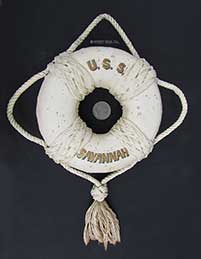
|
5.85 COMMEMORATIVE LIFERING. Very rare ship's relic in the form of an authentically-made miniature lifering. This unusual example of sailor folk art consists of a carved wooden core overlaid by sail canvas tightly stitched on the inner circumference. A laid rope "grab line" encircles the ring attached by 4 sections of interlaced coachwhipping sinnet. At the bottom is a six-bight double strand button knot with trailing fringe. The lifering is beautifully-identified in gold lettering with black "shadow" highlights U.S.S. SAVANNAH. The ring itself measures 5 ¾ inches in diameter by 8 inches wide and 11 ½ inches tall. Excellent overall condition with only minor spotting due to age. There are no losses or damage. Here is a genuine tangible piece of U.S. Navy Civil War history! Civil War relics are hot! 385 The second ship in the U.S. Navy to be named SAVANNAH was laid down in 1820 at the New York Navy Yard. But due to a lack of funding the frigate was not commissioned until 12 years later. SAVANNAH joined the Pacific Squadron as its flagship in 1844. In anticipation of the Mexican War (1846-48), the SAVANNAH and her squadron were positioned off the coast of California. On July 7, 1846 less than two months after war broke out, SAVANNAHsuccessfully captured the provincial capital Monterey, without firing a shot. |
perspective |
back |
ship |
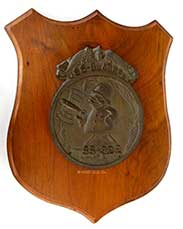
|
5.81/10.74 IMPORTANT WWII SUBMARINE PLAQUE. Original commemorative plaque from the famous U.S. Navy diesel submarine USS BLACKFIN (SS-322). This handsome historic plaque is cast in high relief from solid brass which has acquired a rich statuary bronze age patina. Charmingly, it depicts a 19th century "copper" (policeman) in uniform twirling a torpedo as if it was a nightstick. The top of the plaque displays the submarine service emblem of dolphins flanking a submarine with "USS BLACKFIN" in high relief. The plaque is mounted to a lovely, very rich, solid African mahogany backing in traditional shield form. It measures 11 by 13 ½ inches. The plaque itself is 7 ¼ high by 5 5/8 inhe4s wide. Outstanding original condition. This is a museum piece. 295 USS BLACKFIN (SS-322), a BALAO-class submarine, was the first ship of the U.S. Navy to be named for a fish from the Great Lakes. She was launched on March 12, 1944 by the Electric Boat Company of Groton, Connecticut and was commissioned on July 4th, 1944, Lieutenant Commander George Hays Laird, Jr., in command. During her career, BLACKFIN was used in two famous movies: 1963 "Move Over Darling" with Doris Day, and James Garner; then in 1968 "Ice Station Zebra" with Rock Hudson and Ernest Borgnine. The long-lived BLACKFIN was decommissioned and struck from the Naval Record on September 15, 1972. But even then her usefulness continued as a target to be sunk by a torpedo in the "SubSinkEx Project Thurber" project off San Diego, California on May 13, 1973. Her partial sinking was deliberately used to acquire acoustic data on submarine implosions. |
detail |
back |
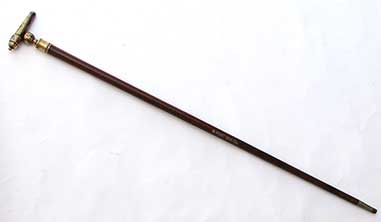
|
5.78 /20.83 HISTORICAL SPANAM WAR PRESENTATION CANE. Very rare authentic gentleman’s walking stick dated 1898 with the rare feature of being a functional cannon! Known as a “cherrot cane” because of its likeness to a cigar of that era, this cane was a presentation piece engraved with the name “Chas W. Test” on one side and the name of the Spanish Naval ship “Reina Mercedes 1898” on the other. REINA MERCEDES was the flagship of Spanish Naval forces in Cuban waters as the station ship at Santiago de Cuba. This solid brass cannon is functional with bore and touch hole. It is mounted atop a brass orb which connects to the collar of the cane with the engraving. It connects to a lovely tiger stripe hardwood cane which tapers to its original brass and iron ferrule at the bottom. The brass surfaces are gold plated. It measures 33 ½ inches long and the shaft is 7/8 inches in diameter at the collar. The cannon is 4 inches long and has a bore of 5/16 inch diameter. This cannon is functional. The inside the barrel has gunpowder residue. The original 29 inch long hardwood shaft has never been refinished and remains in great condition with its beautiful grain pattern and deep brown tiger striping. The bottom of the shaft retains the original 2 inch long nickel silver and iron tip. This walking stick is in outstanding, untouched original condition in all respects, noting some wear to the gold plating. 1995 At the outbreak of the Spanish-American War in 1898, the battle cruiser REINA MERCEDES was serving as a harbor defense ship at Santiago de Cuba. On June 3rd a landing party commanded by Lt. Richmond Hobson attempted to run USS MERRIMAC aground in order to block the channel in the shallow water at the harbor entrance. REINA MERCEDES commended firing with other Spanish ships and shore batteries defending the harbor. MERRIMAC was sunk and Lieutenant Hobson with his seven men were taken prisoner aboard REINA MERCEDES. During the remainder of June and into July, U.S. Navy ships continuously bombarded Spanish positions at Santiago de Cuba, damaging REINA MERCEDES on at least eight separate occasions. Following the destruction of Admiral Cervera's squadron on July 3, 1898, the Spanish scuttled the battered REINA MERCEDES in the channel to prevent U.S. ships from entering. The Spanish towed her to the mouth of the harbor late in the evening of July 3d. But her movements were discovered by the American battleships USS TEXAS and MASSACHUSETTS which took REINA MERCEDES under fire. Their fierce salvos inflicted heavy damage but did not prevent her from sinking at the intended location. Even so, a chance shot cut her mooring lines allowing her to settle in shallow water out of the main channel with her upper works still visible. U.S. Forces overtook the REINA MERCEDES on July 17, 1898 when the Spanish defenses at Santiago de Cuba were surrendered. The U.S. Navy decided to salvage REINA MERCEDES, assigning the famous salvaging company Merritt & Chapman Co. to raise her. Work was begun on January 2, 1899 and she was refloated on March 1st. After extensive repairs the old cruiser was designated as a non-self-propelled receiving ship on December 10. 1902 where she served until 1912. This piece obviously belonged to Charles W. Test, someone of importance who must have served aboard the USS TEXAS or the USS MASSACUSETTS. |
canon |
profile |
touch hole |
ferrulE |

|
5.57 RARE ZEPPLIN PHOTO. Extremely scare original photograph of an equally rare subject. This is a large sepia tone silverplate image of the gigantic American Navy airship the USS LOS ANGELES (ZR-3). It shows a port broadside view of the huge craft flying over pine trees in the foreground. The image is clear with good contrast and no damage. It measures 6 ½ by 10 ½ inches sight and is housed in its original stiff double mat (some corner damage only) measuring 10 ¼ by 14 ¼. 195 |
detail |

|
5.70 / 15.33 FAMOUS ORIGINAL PHOTO. Genuine silver plate photograph of one of the very first “4-piper” destroyers, USS DRAYTON, conducting speed trails. DRAYTON was laid down on August 19, 1909 at the Bath Iron Works Bath, Maine. She was launched on August 22, 1910 and commissioned on October 29th. This photo is signed lower left “USS Drayton Copyright by N. L. Stebbins, Run 25 South 32.88 Knots.” Although undated it is obviously 1910 before commissioning. The sepia tone image clearly shows the sleek vessel belching coal smoke in a mighty effort to attain top speed. Scrutiny under magnification shows crewmen on the bridge and just aft on deck. It is interesting to note this photograph was taken prior to the installation of the ship’s armament. Measuring 7 ½ by 9 ¼ inches sight, it is mounted on the stiff card 9 ½ by 11 ¼ inches. There are a few light stains here and there, but in general the image is clear without faults. A good original photograph by one of New England’s premier marine photographers over 110 years old! 99 |
detail |

|
5.48 U.S. NAVY GRAVY BOAT. Authentic World War II U.S Navy server as used in the Wardroom Officer’s Mess of an American capital ship. This splendid example is the nicest we have encountered in our nearly 40 years in this business. With its oval shape it is complete with built-in tray/base, cover and ladle. The exterior of the boat is embellished with the exquisite hand-engraved Navy emblem of a fouled anchor over the decorative letters “U.S.N.” This is the “fancy “ model with the “ropework” trim on the tray and cover. The cover fits the boat with a precisely and bears a decorative acorn finial on the top. The base is signed “Reed & Barton Silver Soldered.” This silverplate item is with a base metal of brass. Many lesser table service items had a base metal of iron which corroded over time. The interior of this example is perfect, still fit for actual use! It measures 8 inches long by 6 inches wide and stands 5 inches high. A better, cleaner example does not exist. 199 |
DETAIL |
OPEN |
LADLE |
REED & BARTON |
5.23 RARE PHOTOGRAPH GROUPING. Historically important group of 6 original black and white and sepia tone photographs of America’s first and arguably most famous aircraft carrier the USS LANGLEY (CV-1 and AV-3). These photographs show her in both capacities as an aircraft carrier and her later conversion into a seaplane tender. Two of the photographs are identified on the front as “USS Langley” and a third is signed “Browne.” The largest image measures 8 by 10 inches and the smallest 2 ¾ by 3 ¾ inches. All are in very good condition with only minor edge wear. Museum quality. Shipped FREE in the U.S. 249 |
Detail |
detail 2 |

|
5.18 VERY IMPORTANT LIFESAVING PRESENTATION. Extremely rare, highly sought after official governmental award for conspicuous bravery in the saving of life. In this case, the efforts of an isolated lighthouse keeper in the remote area of Grindstone Island are documented in a sterling silver pocket watch. This pure silver hunter case English pocket watch is beautifully engraved on the inside back cover: PRESENTED The watch with double sunk porcelain dial has Roman numerals and minute chapter swept by gold hands. The subsidiary seconds bit is over the VI. The dial is signed “SAML BUCKELY & Co LONDON.” Opening the inner dust cover reveals the high quality, jeweled all brass movement with lever escapement and compensated bi-metallic balance with numerous timing screws. The balance cock is profusely decorated with engraved floral designs. The top plate is singed in fancy script “Sam.. Buckley & Co. LONDON.” Speaking to its quality, this watch is lever set – a feature which prevents inadvertent setting of the time when winding, which is done by the crown. The fine silver case is hallmarked with a lion, anchor and the Gothic letter “g” indicating a Birmingham case maker in 1881/1882. It is further marked with an “[RB]” which may refer to silversmith Robert Beale. The exterior of the case is beautifully engine turned and engraved with the conjoined letters “JRS.” The watch comes in a handsome hinged mahogany case with inlaid mother-of-pearl shield on the lid. The button latch opens to reveal the lavish green felt-lined interior. The watch measures 2 ¼ inches in diameter, 3 1/8 inches high inclusive of the stem wind and bow, by ½ inches thick. The custom case measures 5 ¾ inches wide by 4 1/8 inches deep and is 1 ¼ inches thick. This watch is in good running condition, having just been serviced by a certified watch maker. It is excellent cosmetic condition inside and out, with no significant flaws, just evidence of careful use. At the time, Grindstone was a small, isolated island in the mouth of Chigneto Bay on the Bay of Fundy, just north of the Saint John on the southern coast of New Brunswick, Canada. The light station was erected in 1859. Subsequently the original lighthouse was replaced in 1908. After a devastating fire, it was reconstructed. However the existing lighthouse has fallen into a state of disrepair. Further research on the lighthouse keeper’s name, John R. Stiles, and the Brig Annie Bogart will undoubtedly reveal much more fascinating information in addition to that which we have already provided here. |
perspective |
box |
in box |
case |
dial |
presentation |
hallmarks |

|
5.03 U.S. LIGHTHOUSE SERVICE BAROMETER. Genuine late 19th century aneroid barometer made for the United States Lighthouse Service by the respected early French firm of Paul Naudet, Paris as marked on the lower center of the dial “PNHB” and again stamped on the back of the case. This precision instrument contains the highest quality barometer mechanism available at that time. It registers atmospheric pressure on the enameled paper dial with a the wide range spanning 25 inches of mercury to 32 inches, marked in tenths and sub-divided to 2/100ths. The reading is indicated by a thin blued steel needle which is overlaid by a brass “set needle” connected to a knurled knob to record a prior reading. The dial is marked “MADE IN FRANCE” at the top and “U.S.L.H.S.” at the bottom along with the notation “HOLOSTERIC BAROMETER (PNHB).” The beveled glass crystal is housed in its rolled brass bezel with silvered reflector ring. The solid brass case is remarkable in that it is wall-mounted with 3 attachments versus the more typical ship application using a pivoting suspension loop – an obvious indication of its terrestrial use in a lighthouse. There is an aperture on the back for adjusting the reading. 5 ¼ inches wide overall and 2 1/8 inches thick. Outstanding original condition, very accurate, showing just enough good age. A real rarity amongst barometers!
|
PERSPECTIVE |
DIAL |
BACK |

|
5.99 IDENTIFIED SAILOR HAT. Most scarce early 1900’s seaman's hat from the famous World War I British battleship, HMS BARHAM as indicated on the silk hat ribbon in bold gold letters. This bowler style straw hat was professionally made with the rim exhibiting a finely sewn tan cloth edge. The top bears a beautifully hand-embroidered compass rose in gold thread. The interior liner is also hand-sewn. 12 inches long by 11 inches wide. Amazing original condition for such a delicate item, considering it about 100 years old! 449 |
TOp |
INSIDE |
ship |
EXPLOSION |

|
5.25 EXTREMELY IMPORTANT HISTORICAL COLLECTION "USS BEAR." This is an incredible find, consisting of the original signed, dated and identified telescope used on board the USS BEAR during the Greeley Polar Relief Expedition in 1885, 2 large framed period photographs of the Brigantine BEAR and a period scratch-built model of the vessel! Also included are a number of charming original deck views with physical photographs of her last commander, Captain C. S. Cochran. Contained in the offering are several original copies of official correspondence from the BEAR dated 1921 through 1923, including a letter with Admiral Richard Byrd's name pencil signed at the top and an envelope printed "Byrd Antarctic Expedition II, S.S. Bear of Oakland" postmarked "Little America Antarctica Jan 30, 1934." There are a number of personal letters and other memorabilia from Captain Cochran including a lovely hand-engraved copper printing plate depicting the BEAR in an ice floe and reading, "Seasons Greetings, U.S. Coast Guard Cutter 'BEAR'." There is a an extensive collection of period newspaper articles from the 1920's and 30's pertaining to the BEAR. All of these genuine items have come down through the Cochran family via the late daughter of Captain Cochran, Frances Cochran Hartray. The large hand-held telescope is a high quality 4-draw instrument with leather covered main barrel and built-in sun shade measuring 44 inches fully extended and collapsing to 12 1/2 inches long closed. It has a pivoting eye-piece dust cover with sun filter and a perfect 2 1/4 inch diameter objective lens. Two brass bands encircle the main tube. The first is engraved "U.S.N. THE BEAR 1885." The second is engraved "WILKINSON & BAXTER, BOSTON MASS." This telescope is in outstanding working condition producing a large, highly magnified, clear image with its all original optics. Excellent cosmetic condition noting some abrasion to the original leather coverings and evidence of use expected from a working instrument over 130 years old. It comes complete with a custom-made shadow box display with engraved brass plaque reading "USS BEAR ARCTIC EXPEDITION 1885." There are two original photographs of the BEAR. The first is an albumen type showing BEAR anchored in pack ice and is signed and dated lower left, "J.M. Justice `95." The second photo shows BEAR in San Francisco Bay with Oakland in the background and two of its boats in the water, circa 1930. The cased model of the BEAR is of scale, museum-quality construction with even the finest details depicted. All aspects of the ship are hand-made. This is not a kit model! The hull is of solid wood construction with all other components being of wood and metal. Attesting to its quality, all of the numerous dead eyes on this model are made of ivory! Seeing is believing. This model is truly worthy of being displayed in the finest public collection! The ship itself measures 28 inches long, 17 inches high and 6 inches wide. It is housed in its original glazed oak case measuring 32 1/2 inches long by 9 inches wide and 21 1/2 inches high. A truly exceptional presentation of original items of very significant historical importance! Sold as a group. SOLD Built in Greenock, Scotland in 1874, the steam/sail whaler BEAR was engaged in the whaling and sealing trade out of Dundee, Scotland for eleven years. In 1885 this proven, staunch Arctic vessel was purchased by the U.S. Navy to aid in rescuing the famous Greeley Polar Expedition. When relief efforts were successfully completed BEAR was transferred to the U.S. Coast Guard and stationed at San Francisco. There, for over forty years she made regular annual cruises to Alaskan waters and acted as flagship for the famous explorer, Admiral Richard E. Byrd. BEAR also acted to protect the seal fisheries and extended aid to merchant ships in distress. BEAR was looked upon as "mother" by thousands of Eskimos in the Territorial Alaskan frontier who looked to her for protection from foreign exploitation. |
byrd letter |
letter |
copper plate |
in the arctic |
capt cochran & hector |
telescope |
telescope 'bear' |
telescope closed |
telescope maker |
telescope display |
in 1895 |
in the ice |
in oakland |
ship model |
focsle detail |
stern view |
stern detail |
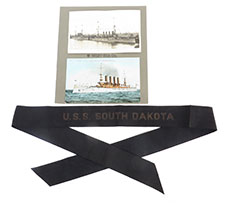
|
5.87 FAMOUS EARLY BATTLESHIP GROUPING. Rare compilation of 3 items relating to |
detail |
south dakota white fleet |
South dakota & Pueblo |

|
5.08 LIFESAVING SCENES. 1850 or earlier artistic depictions of various lifesaving scenes and apparatus contemporaneous to the period. A total of 11 vignettes very precisely depict the various aspects, each captioned below the image. It is entitled “APPARATUS FOR SAVING LIFE IN CASE OF SHIPWRECK.” The end of the page is marked “LIFE SAVING PLATE CVI” and was produced by “Blackie & Son London. Glasgow & Edinburgh." These engravings are of superb quality with the finest detail, bearing scrutiny under magnification printed on high quality stock. 6 ½ by 9 ¾ inches. Outstanding original condition. Very rare and highly desirable subject matter depicting the infancy of lifesaving techniques. Perfect for framing. 59 |

